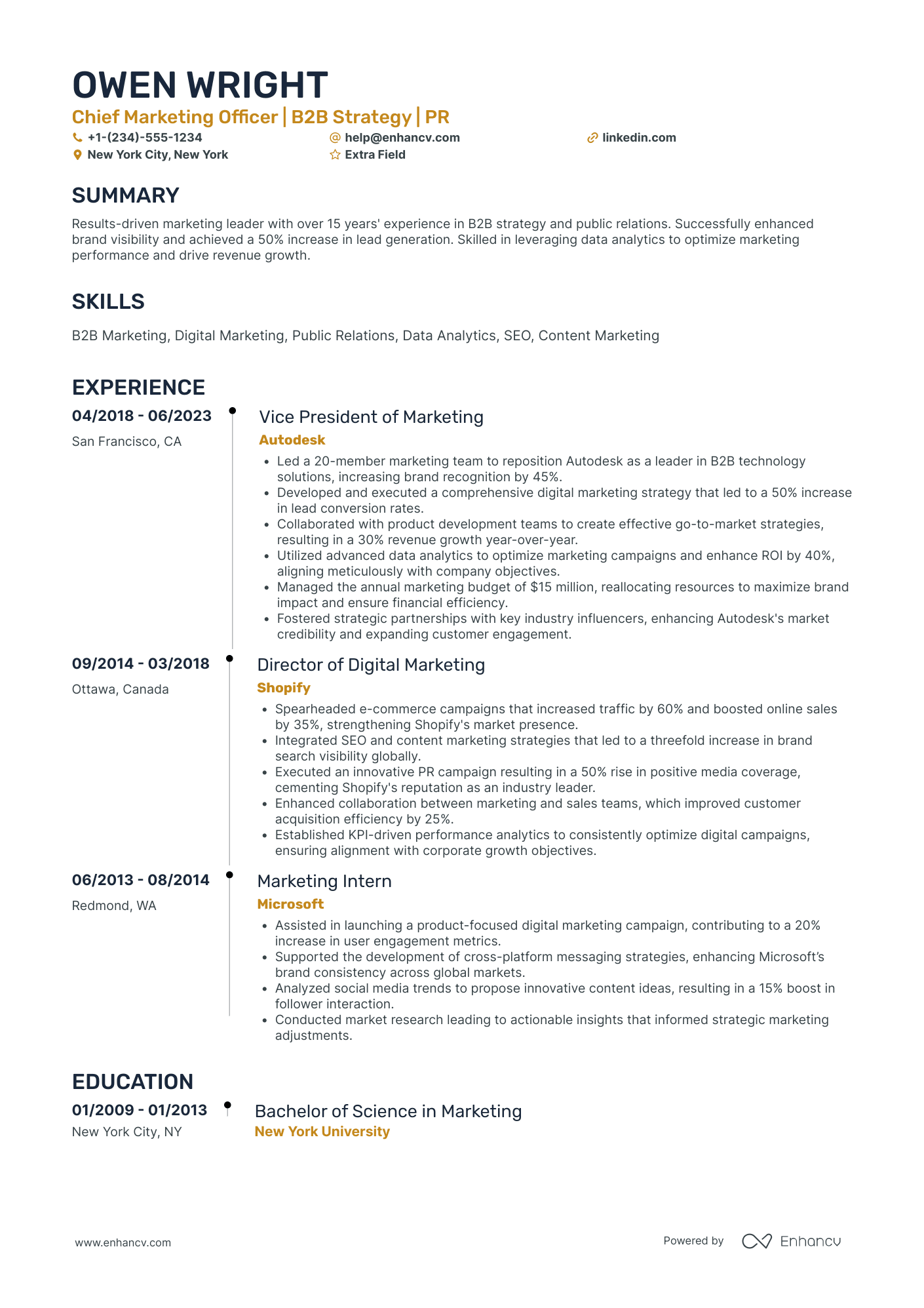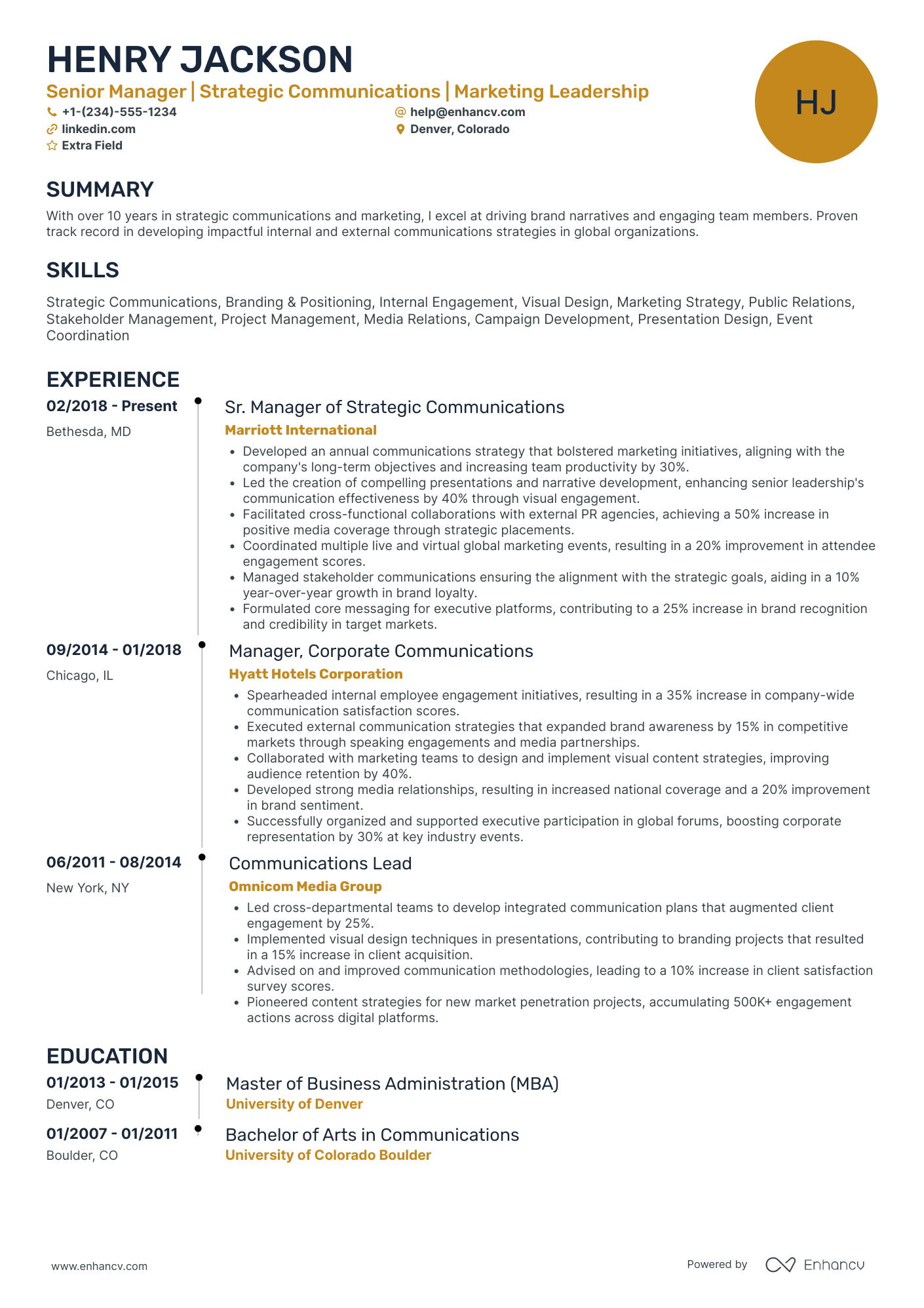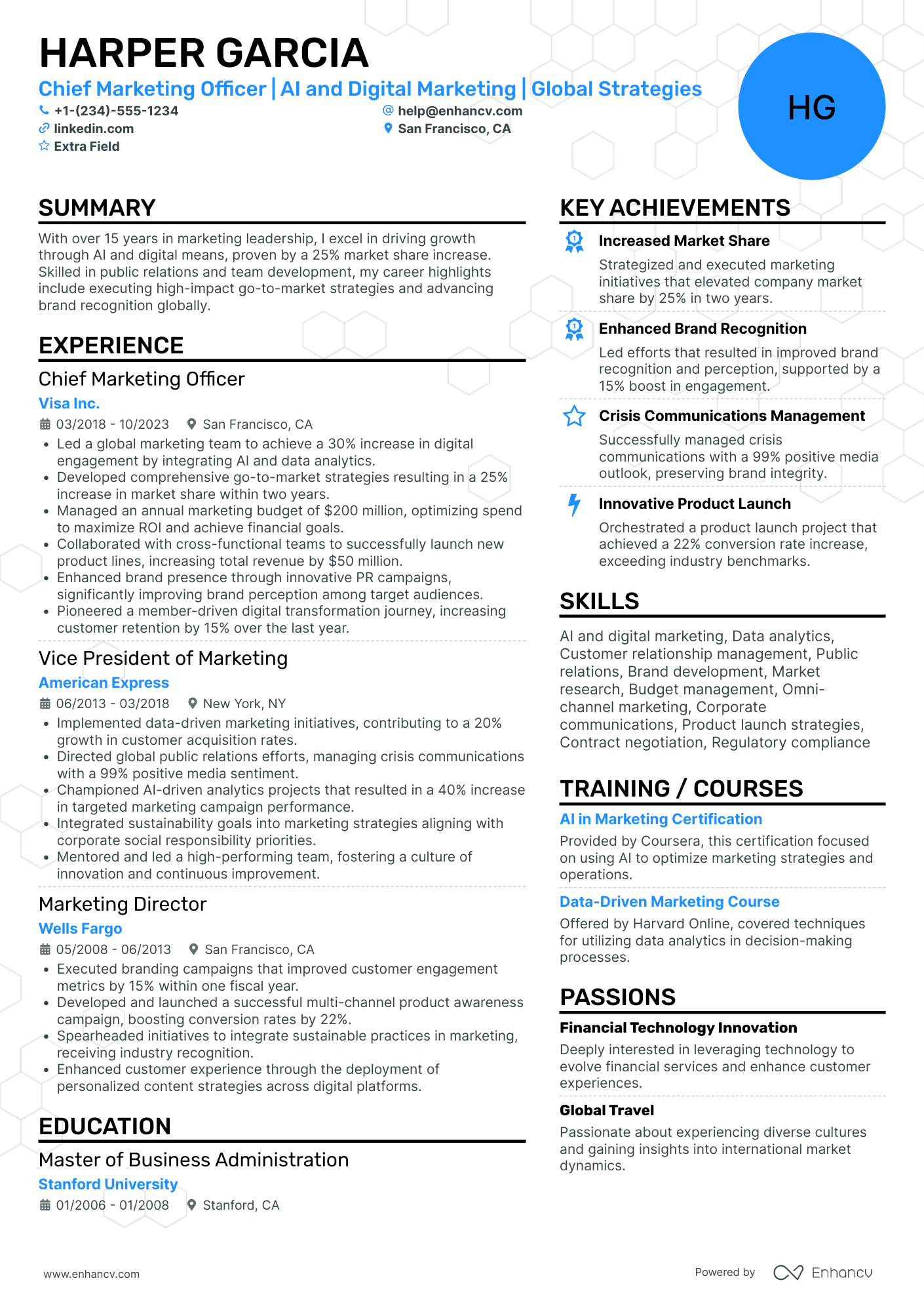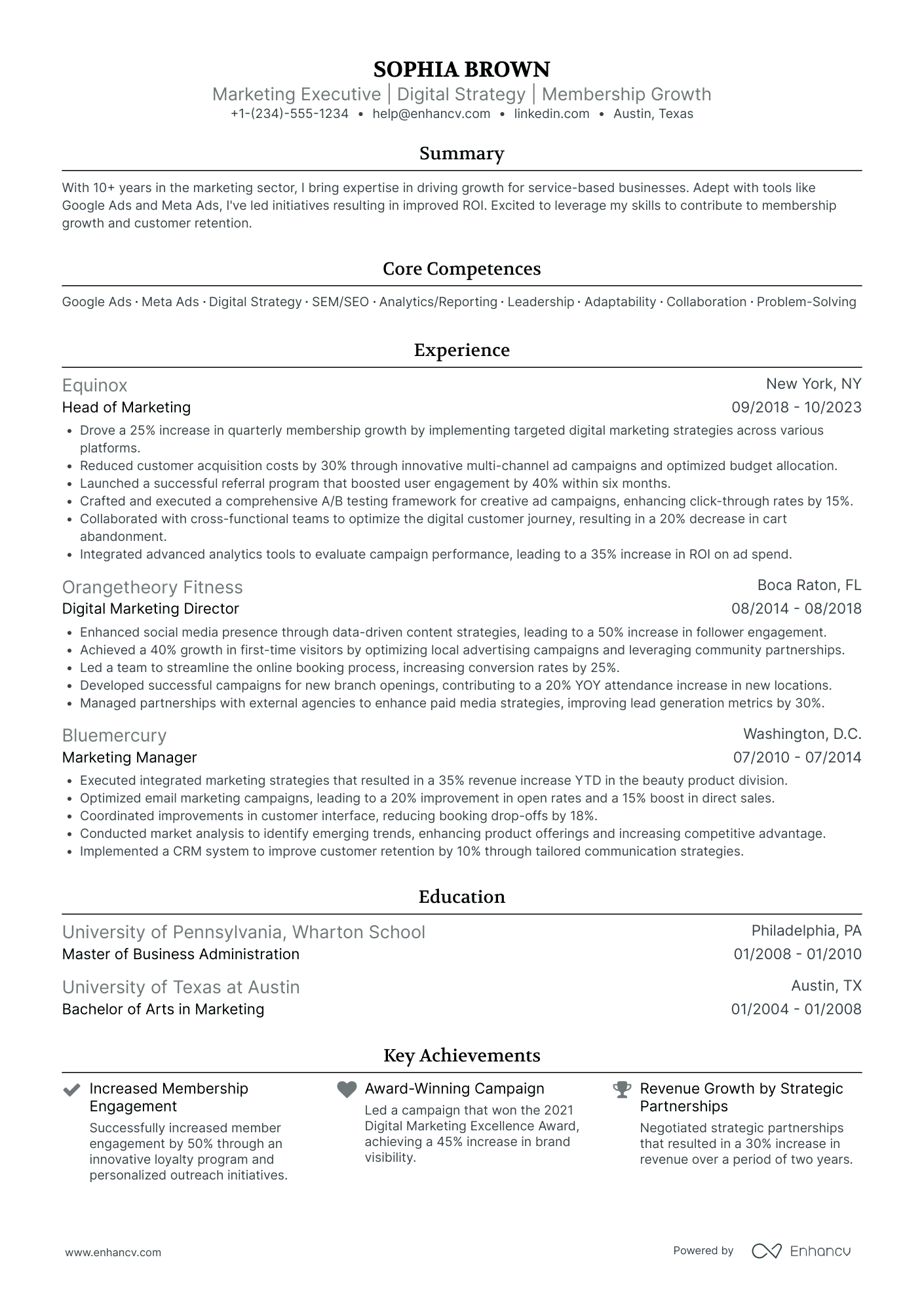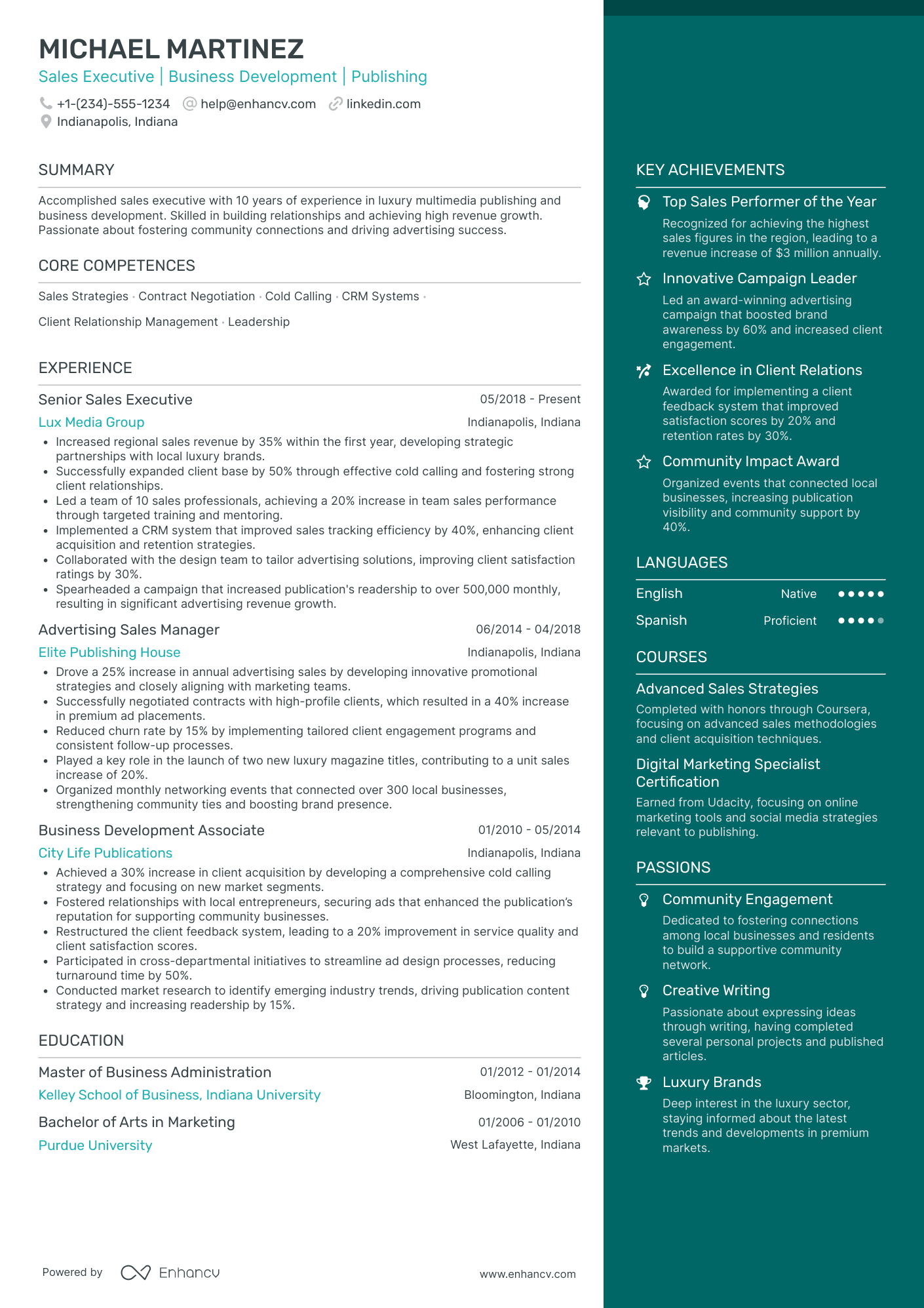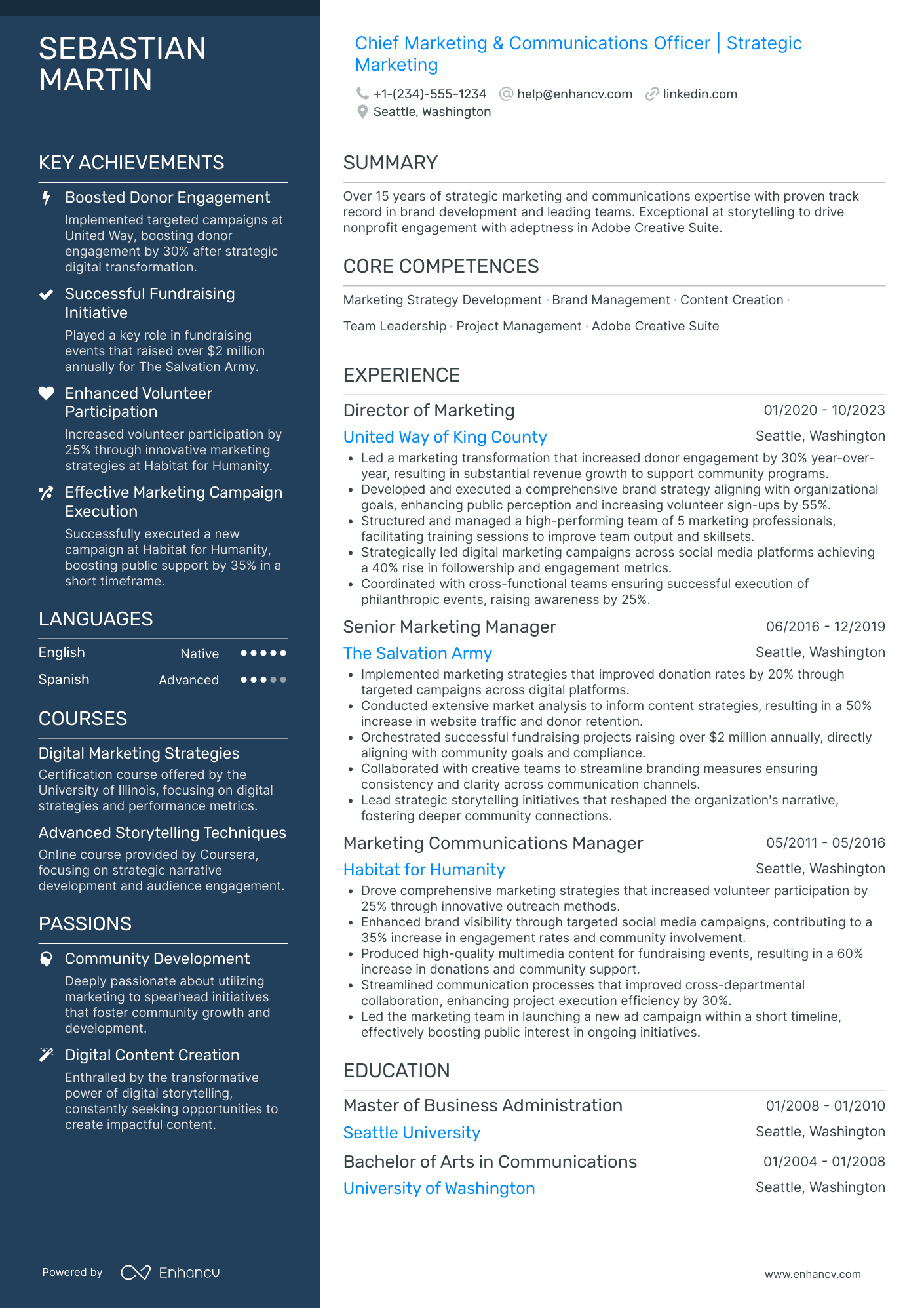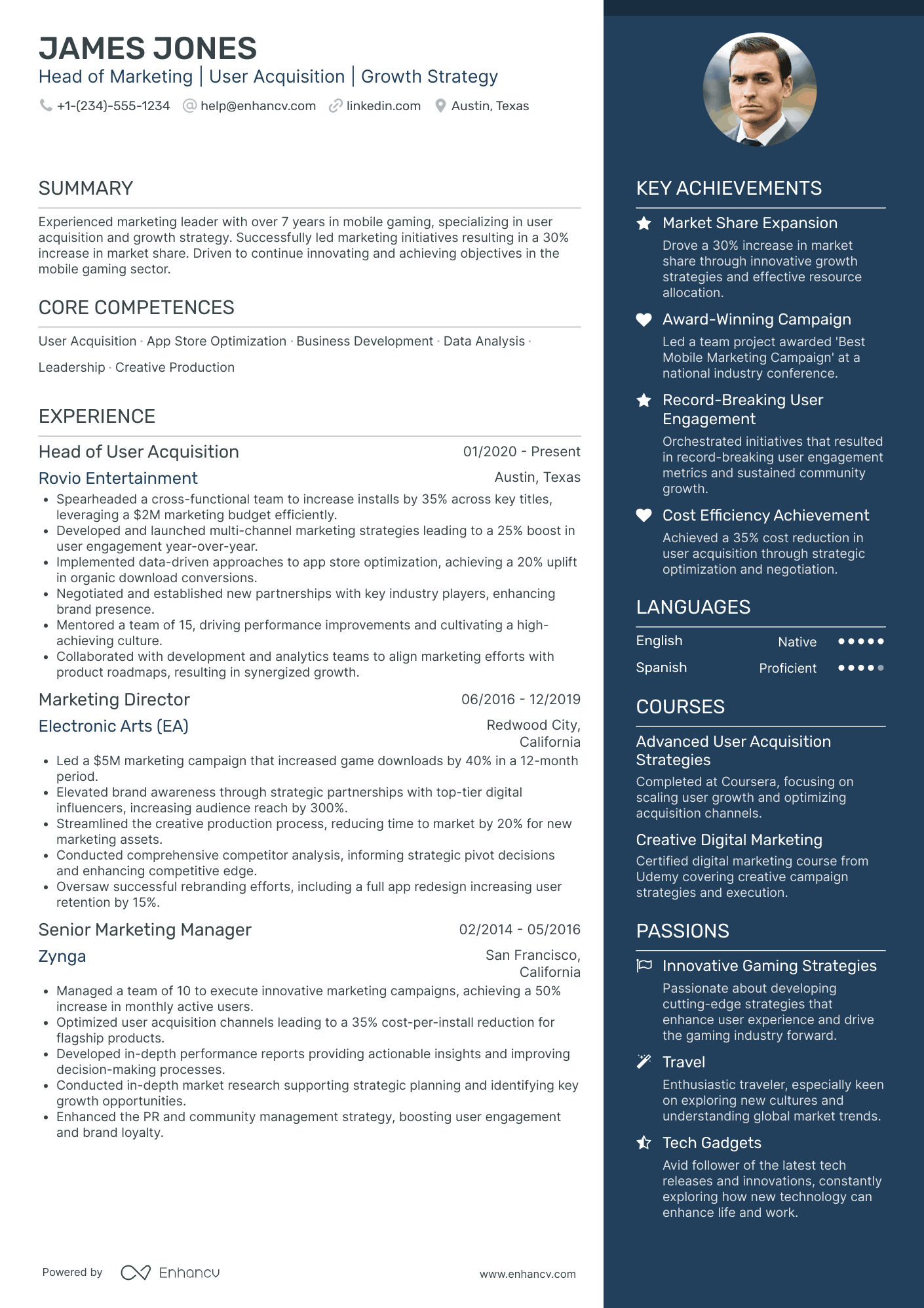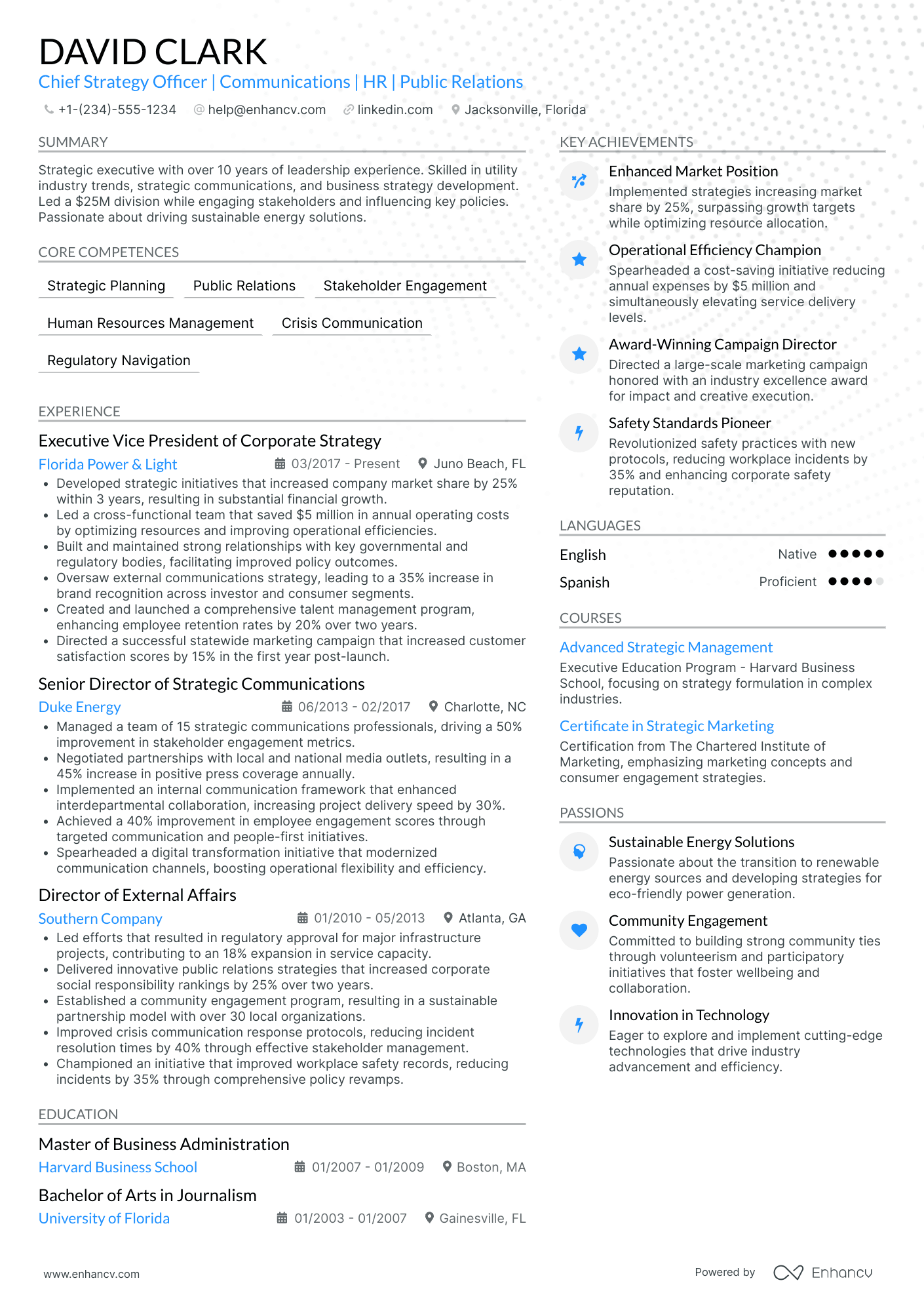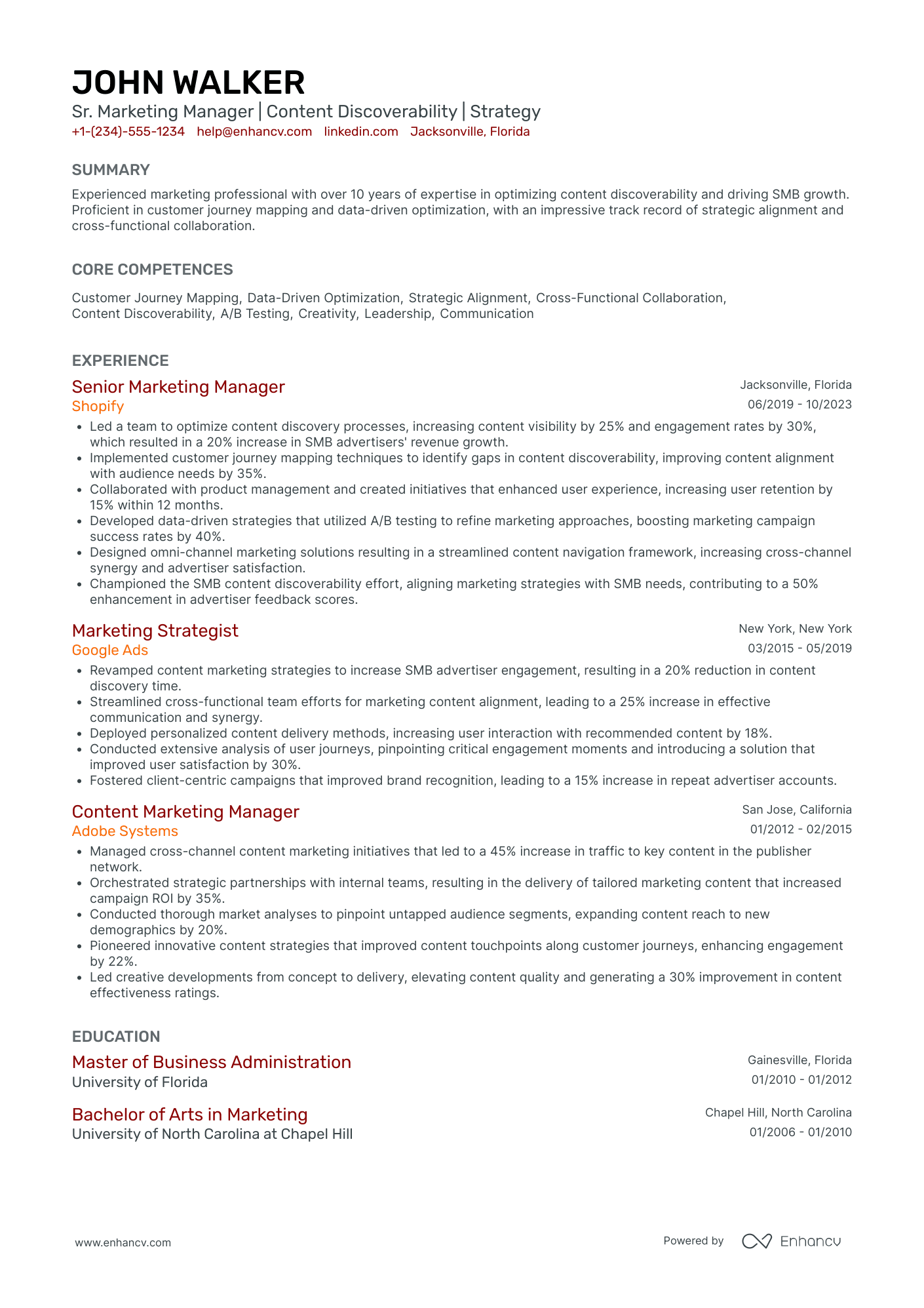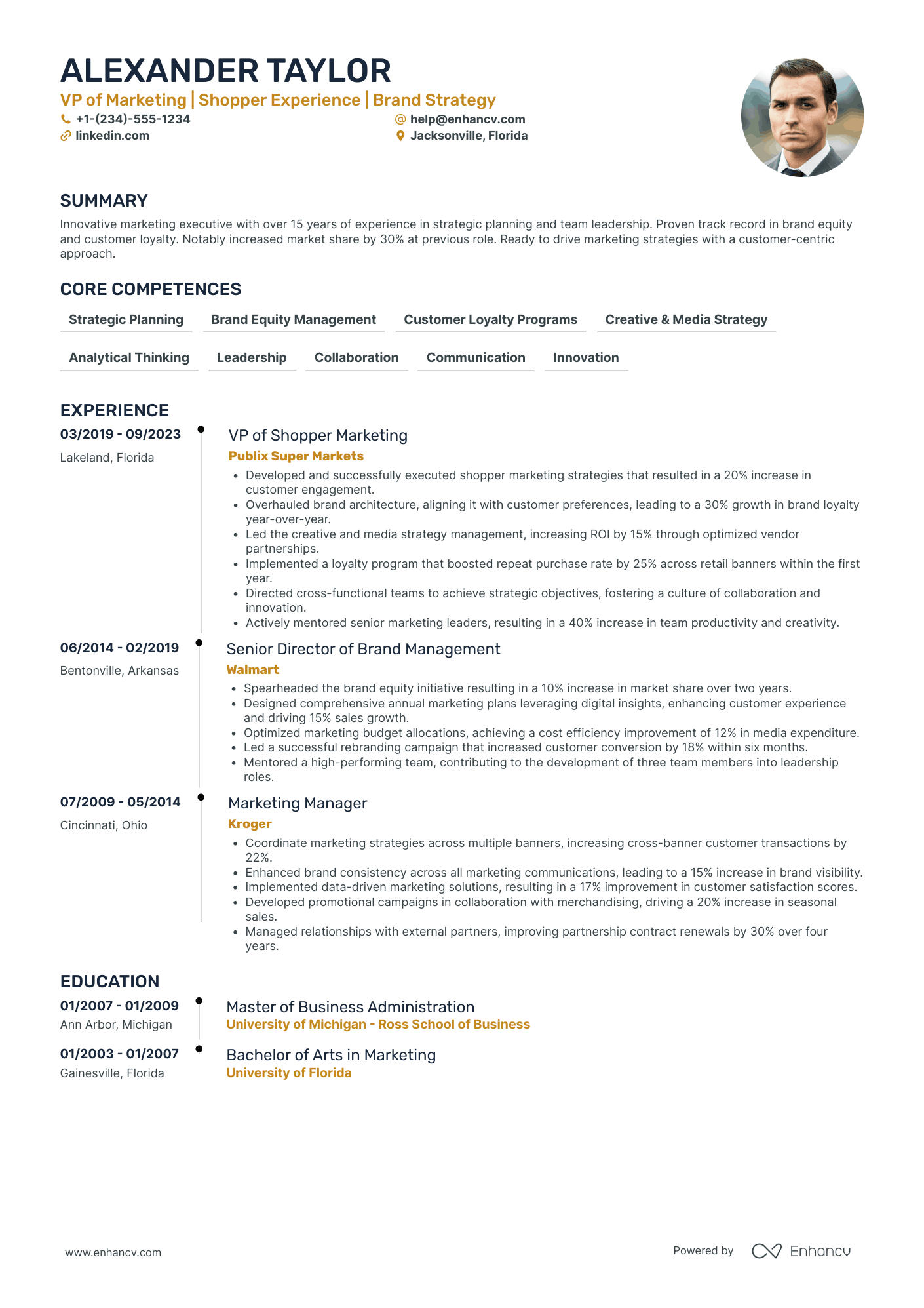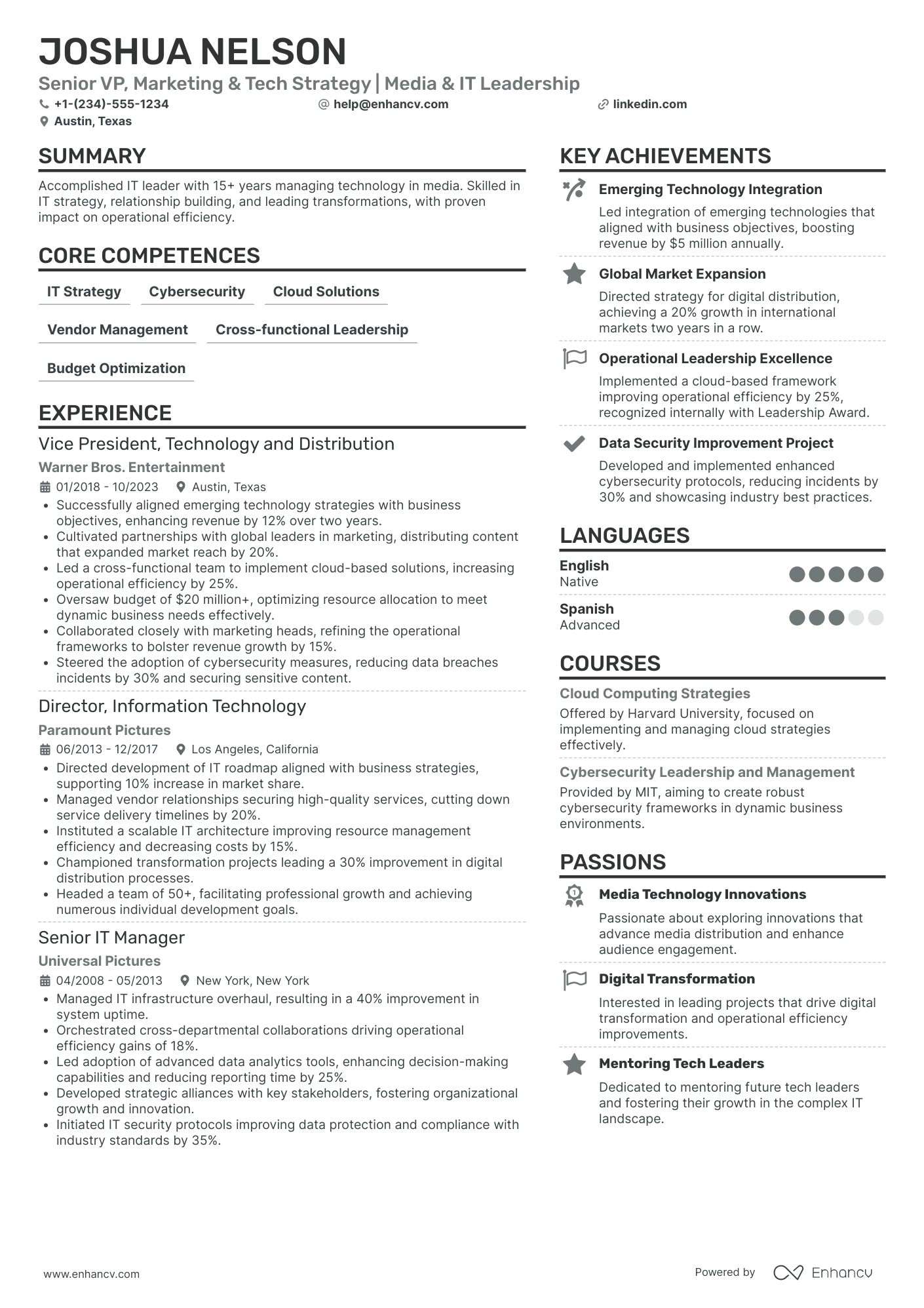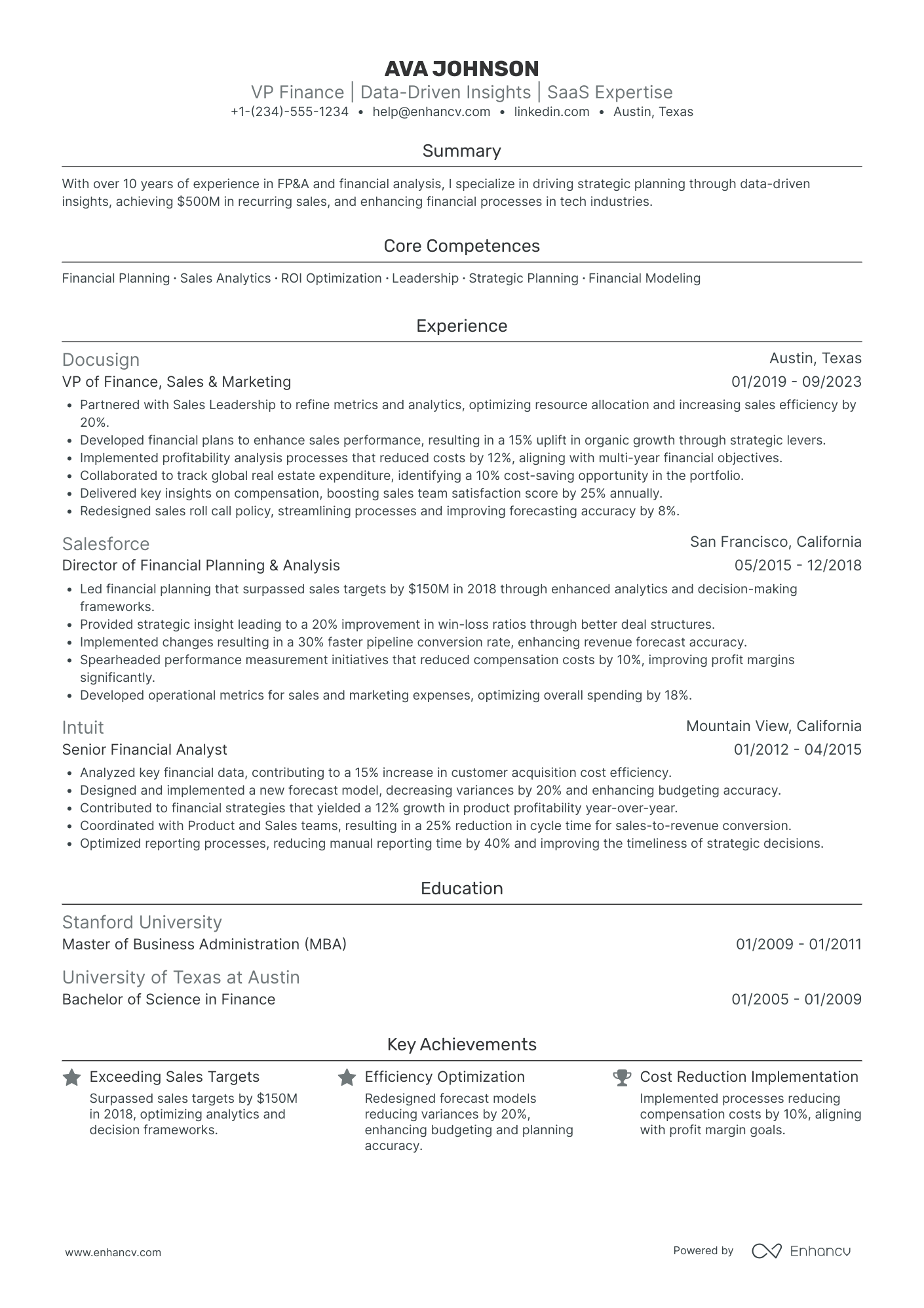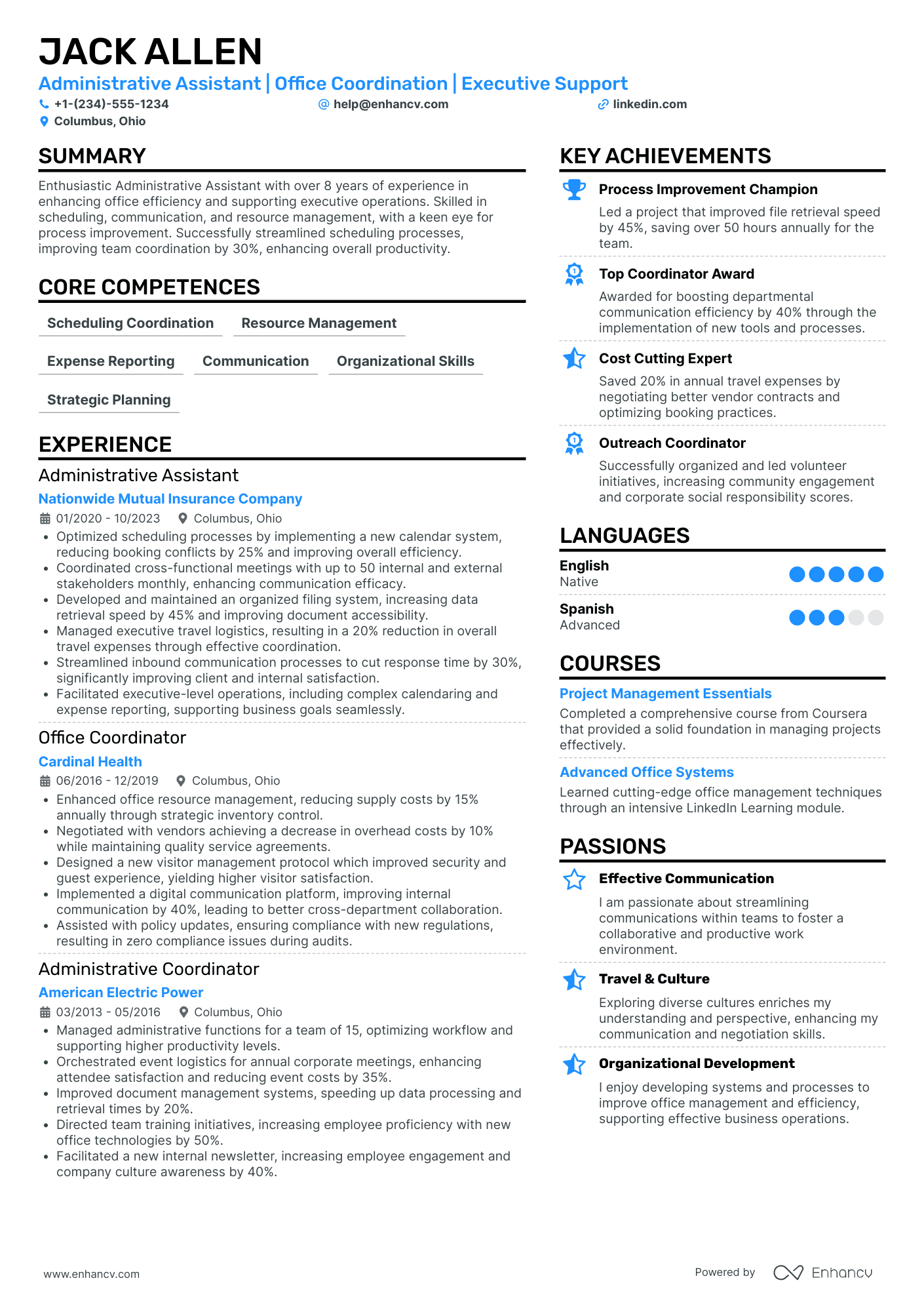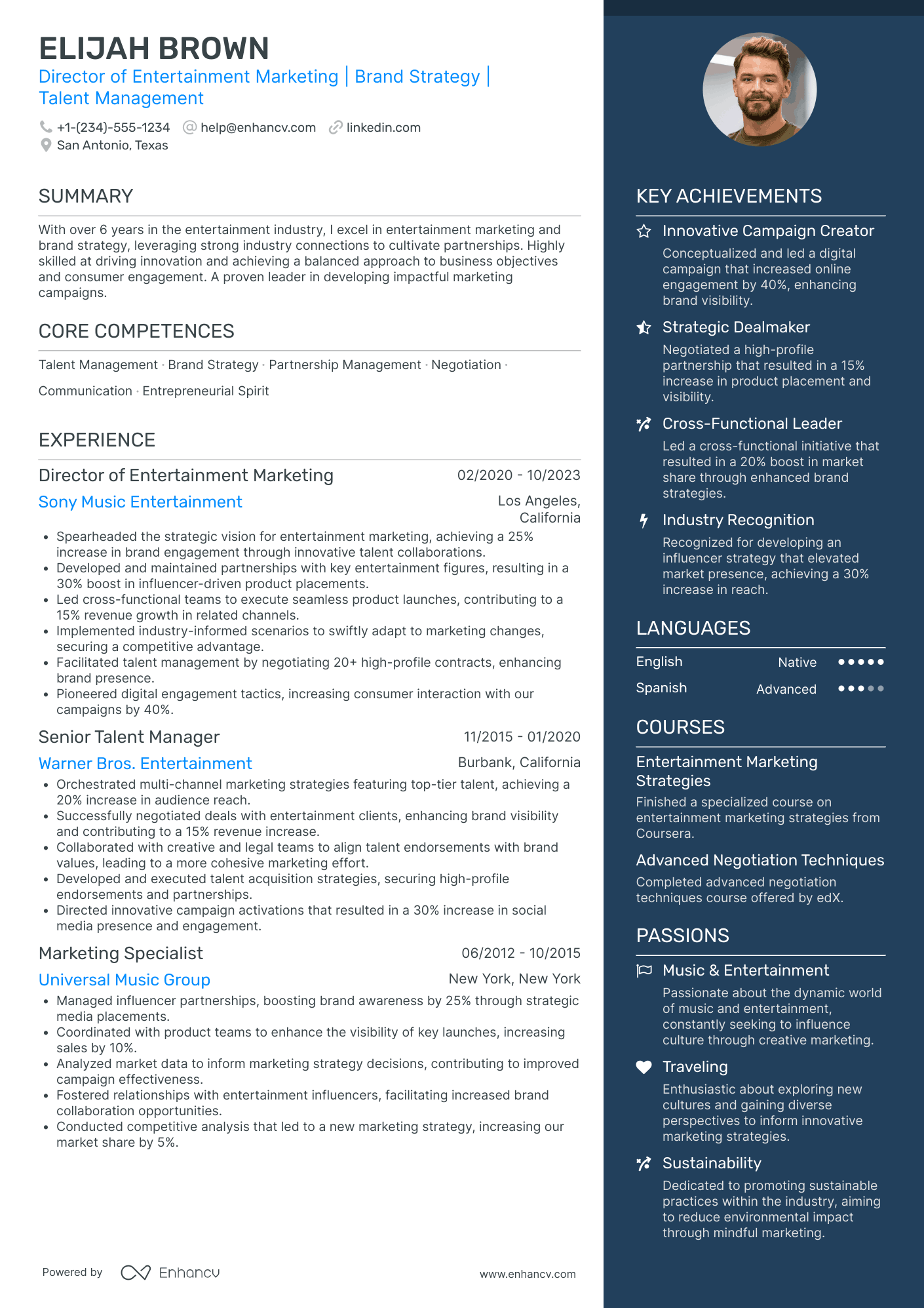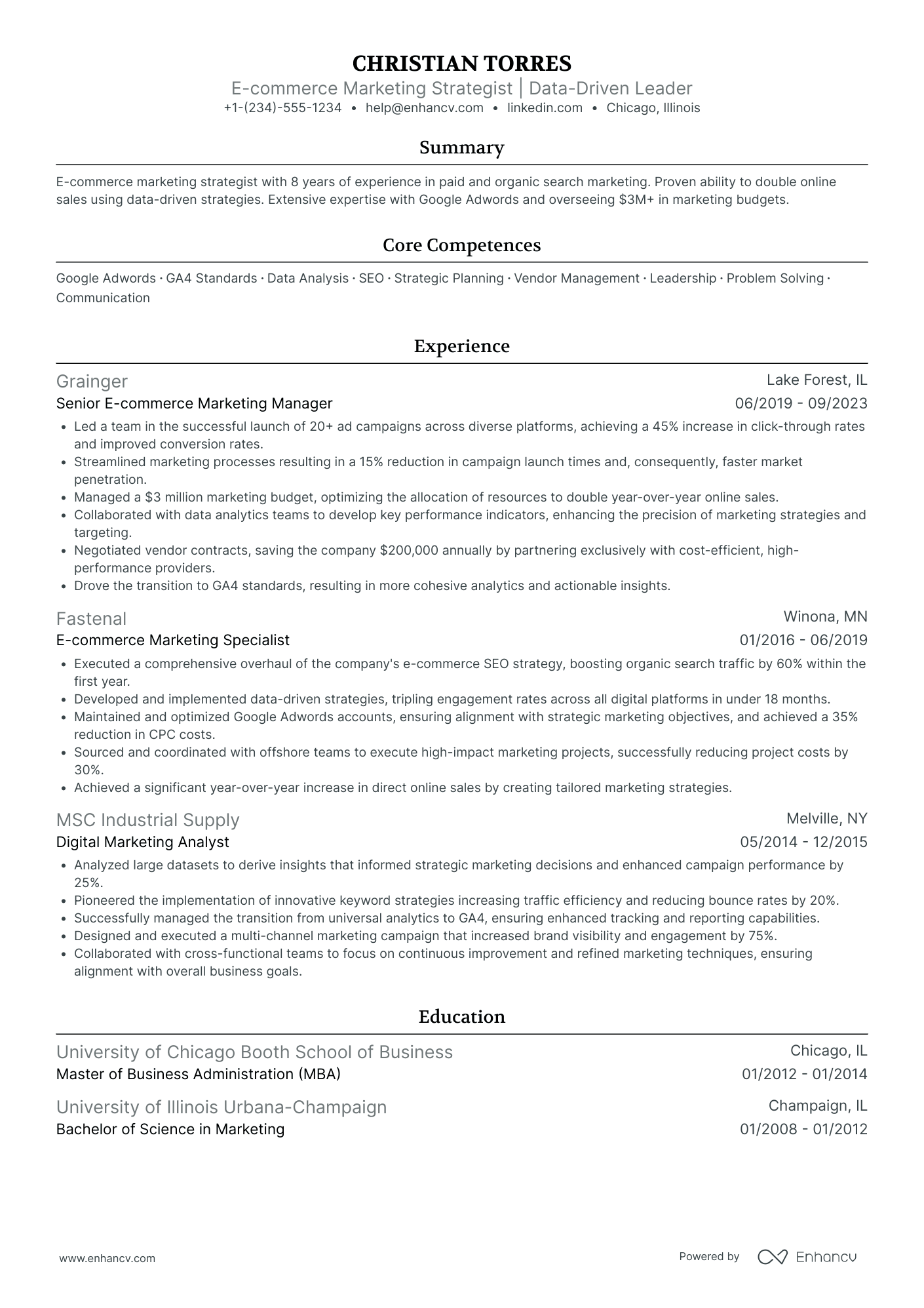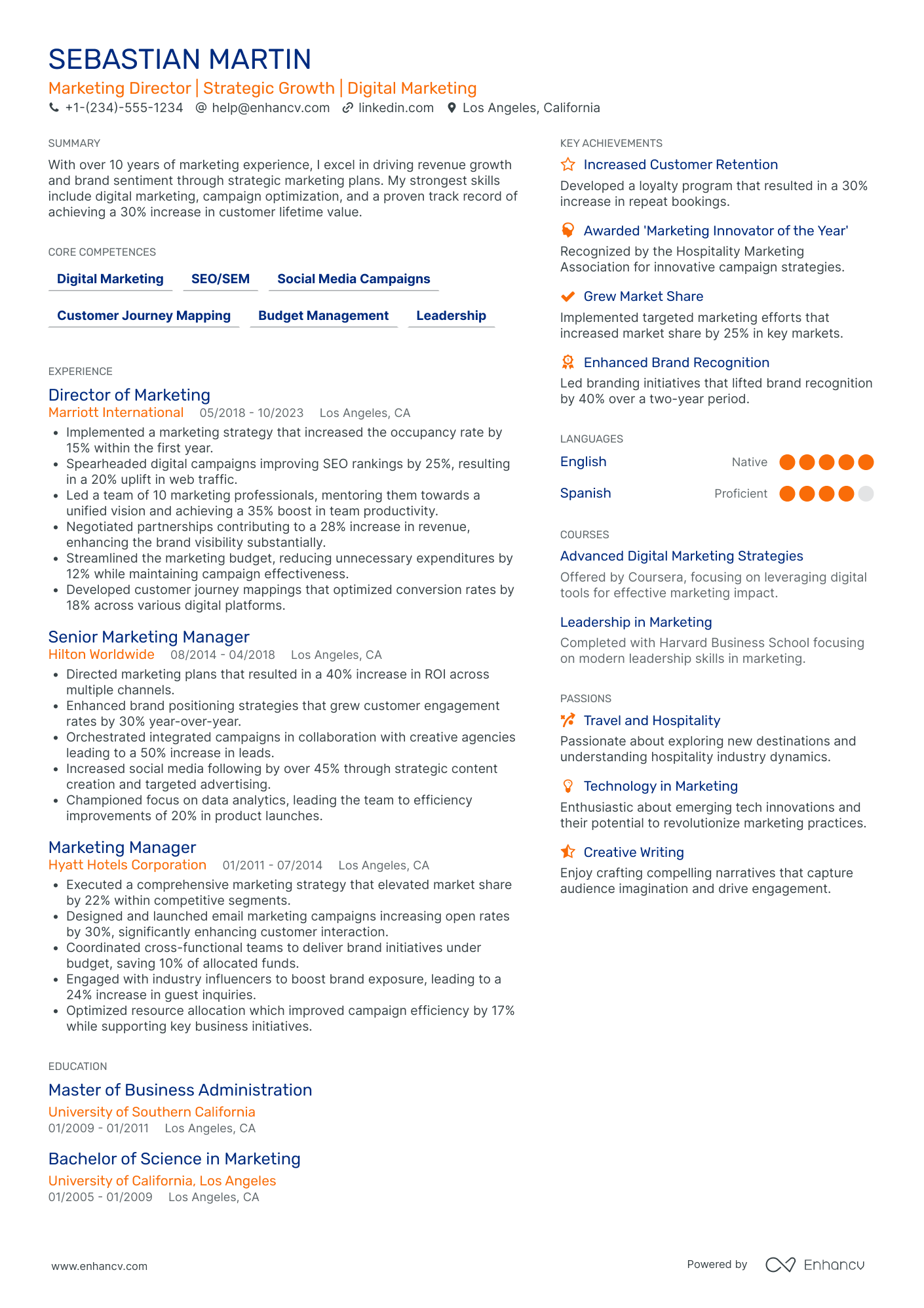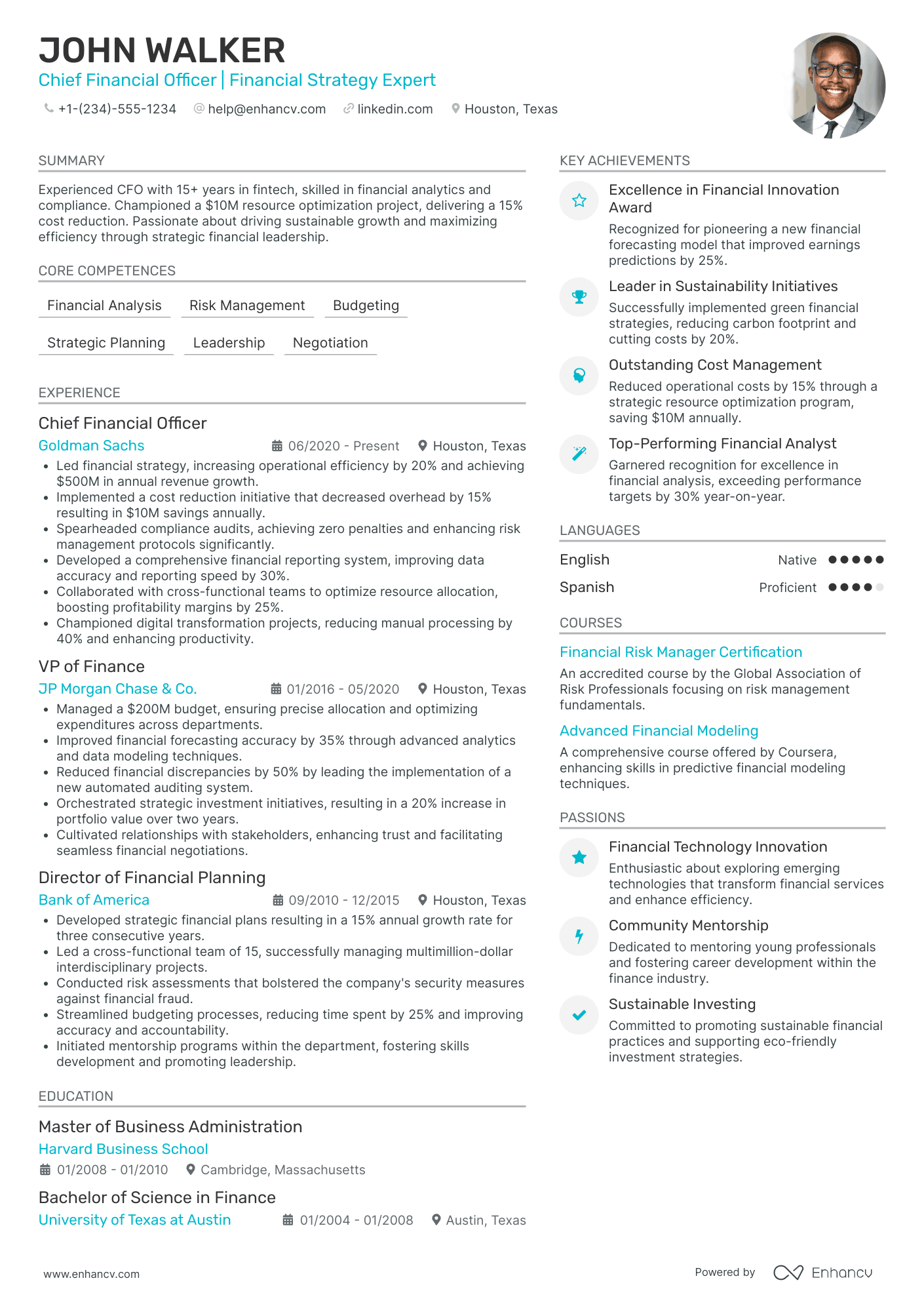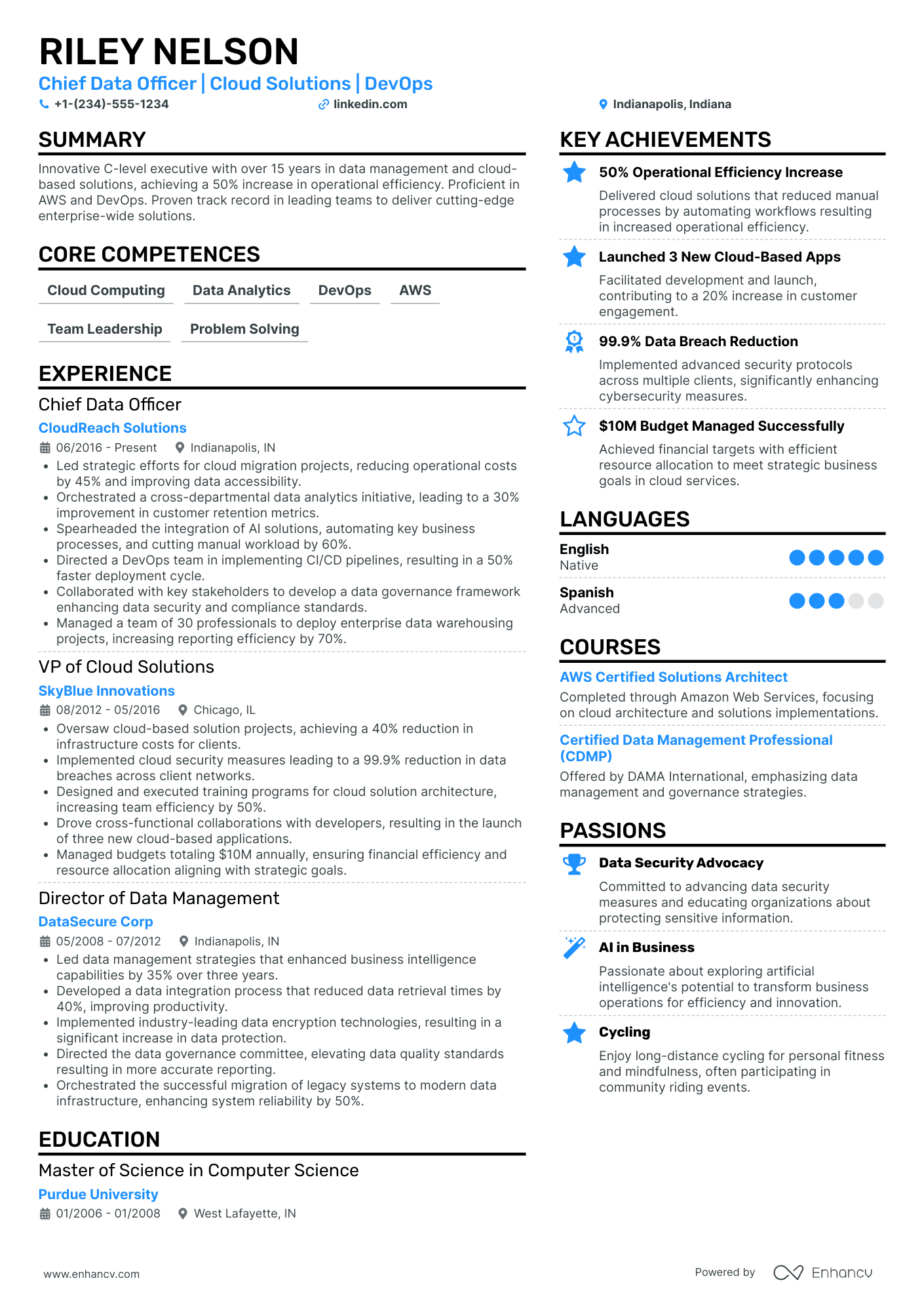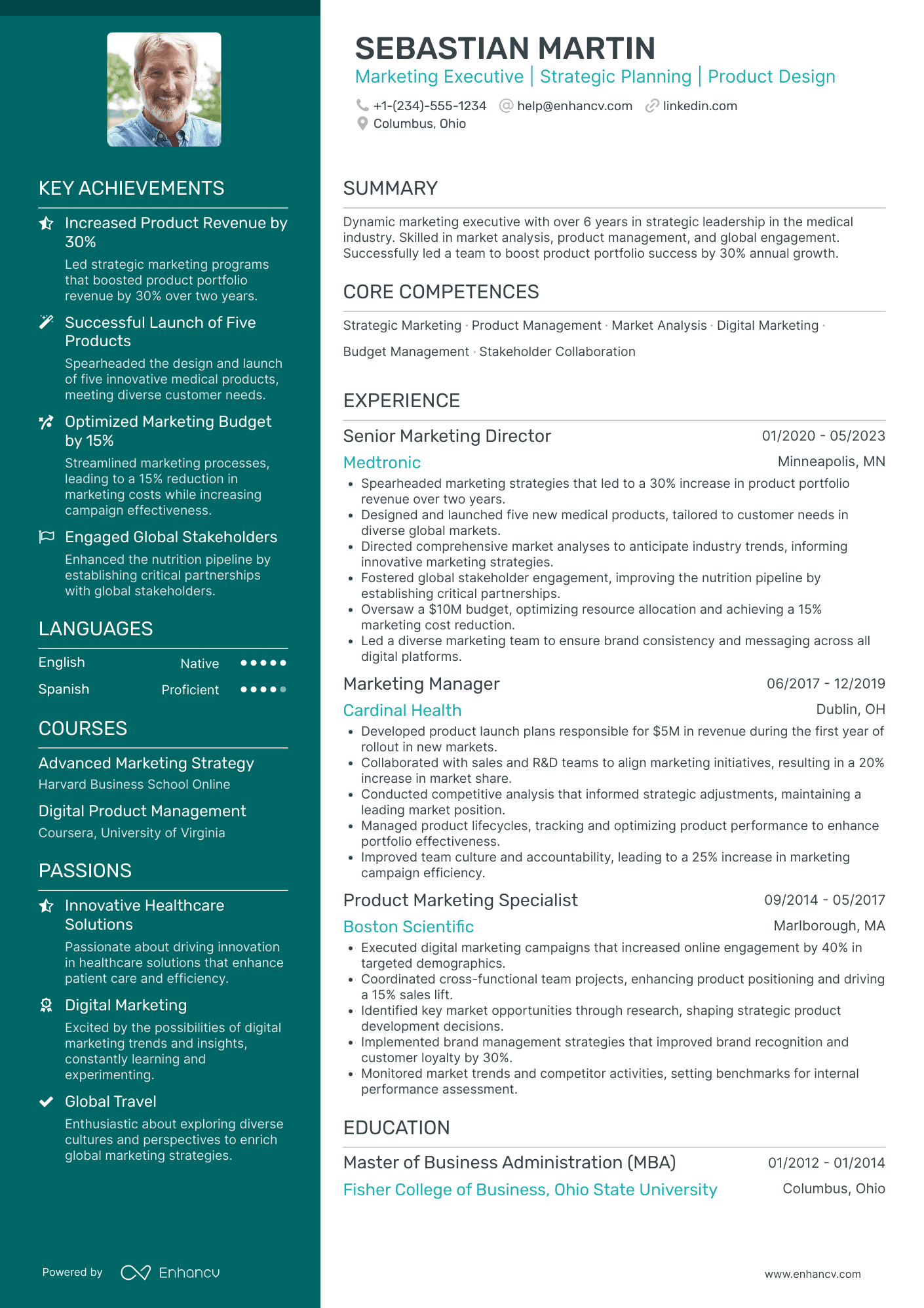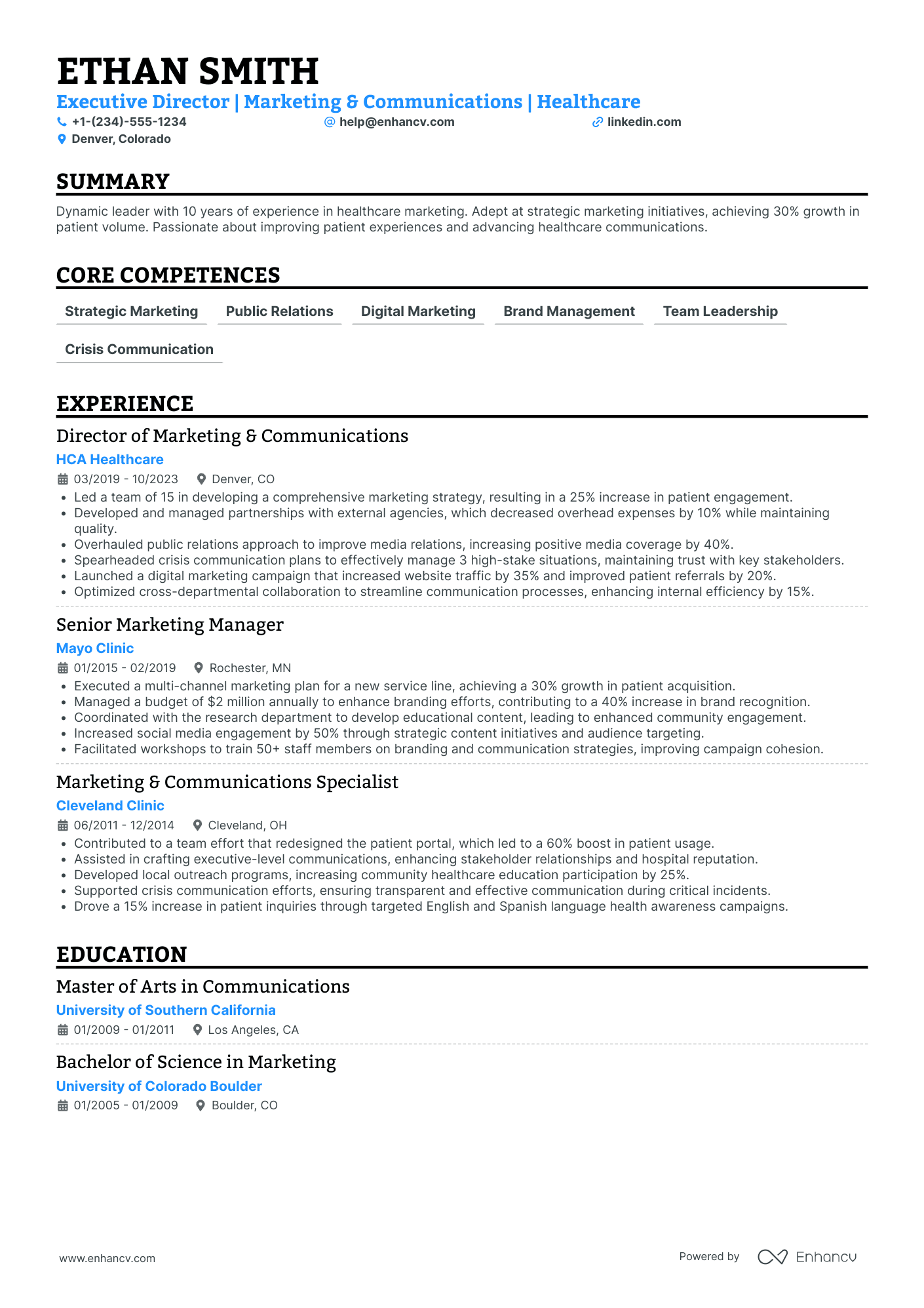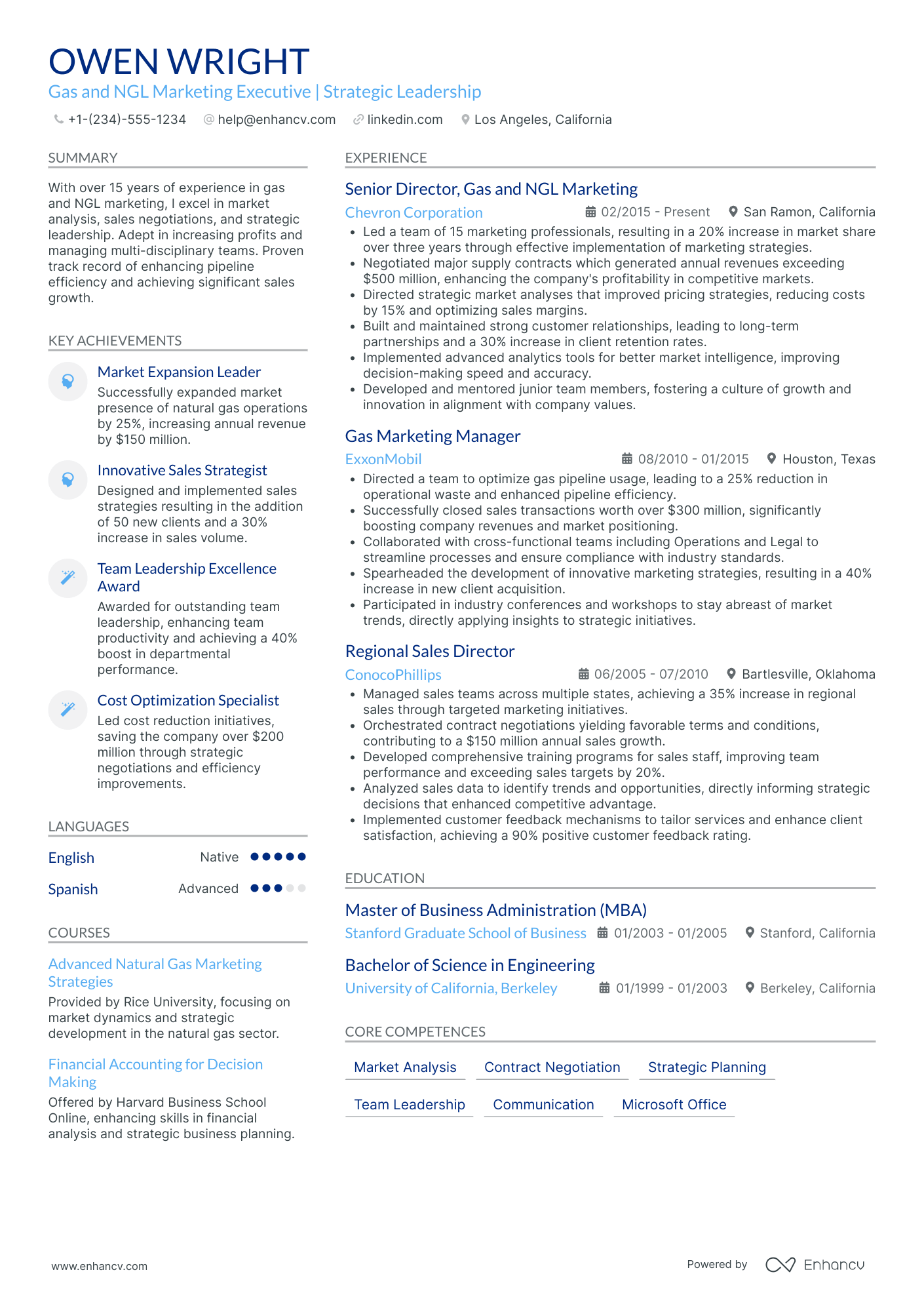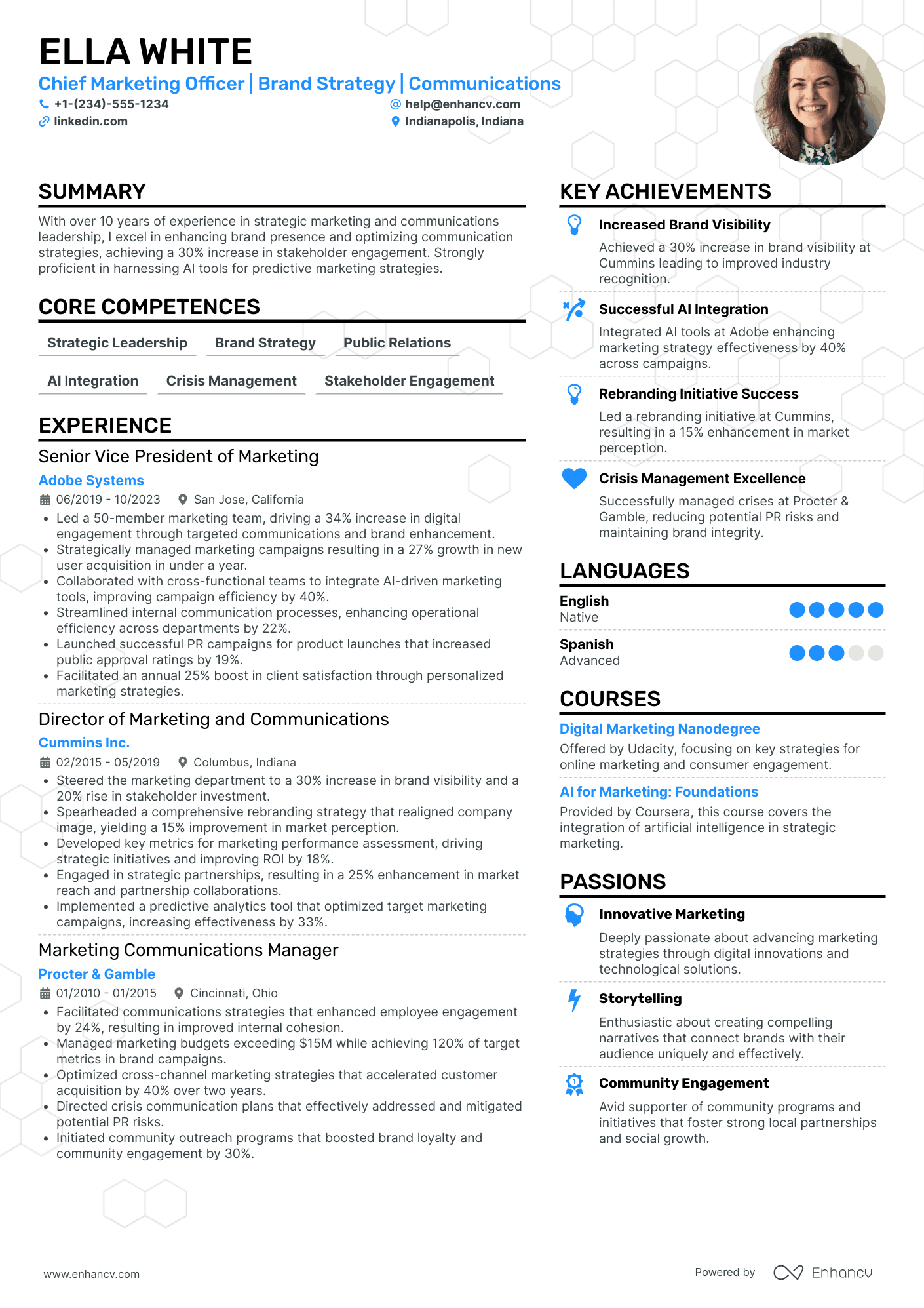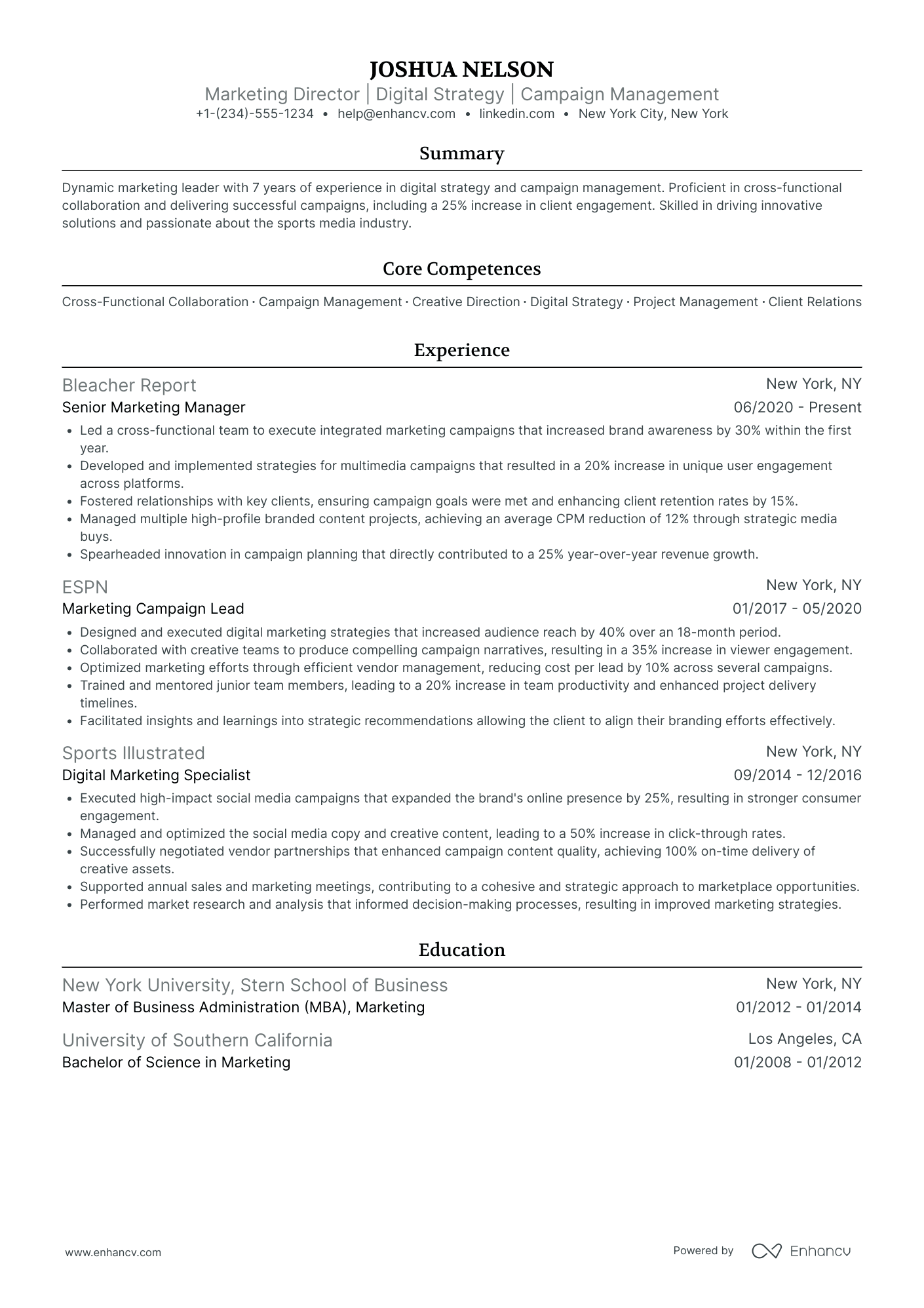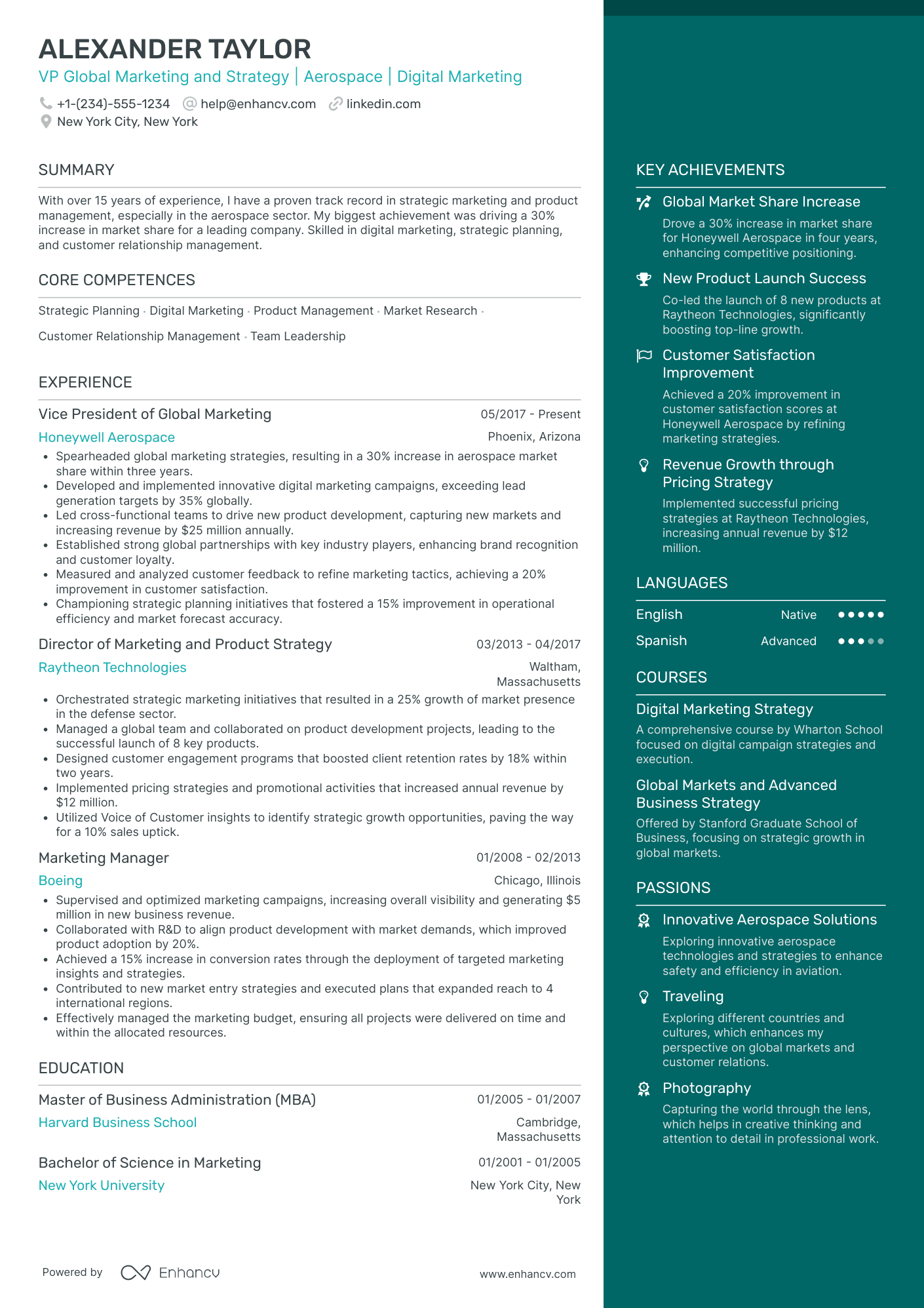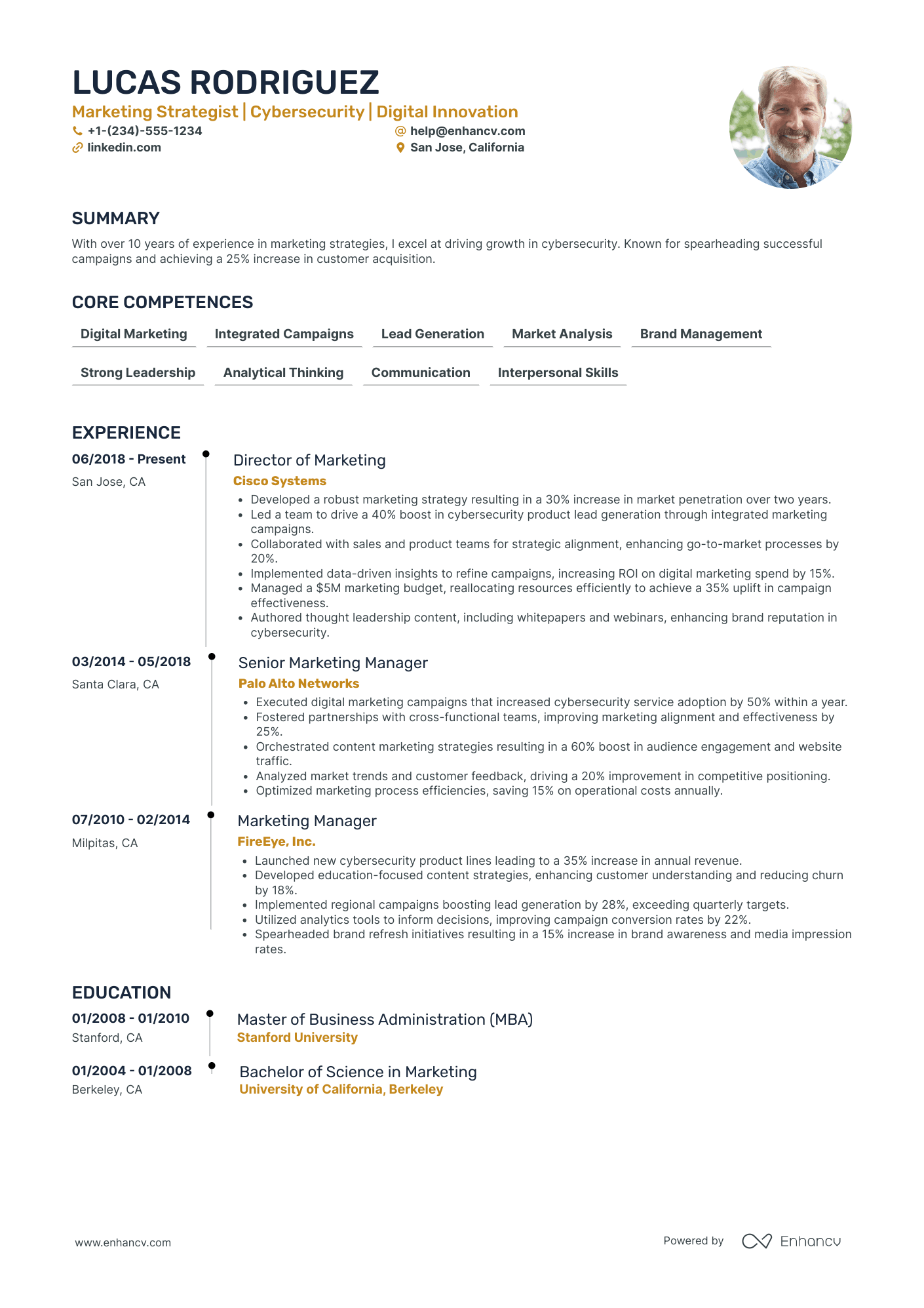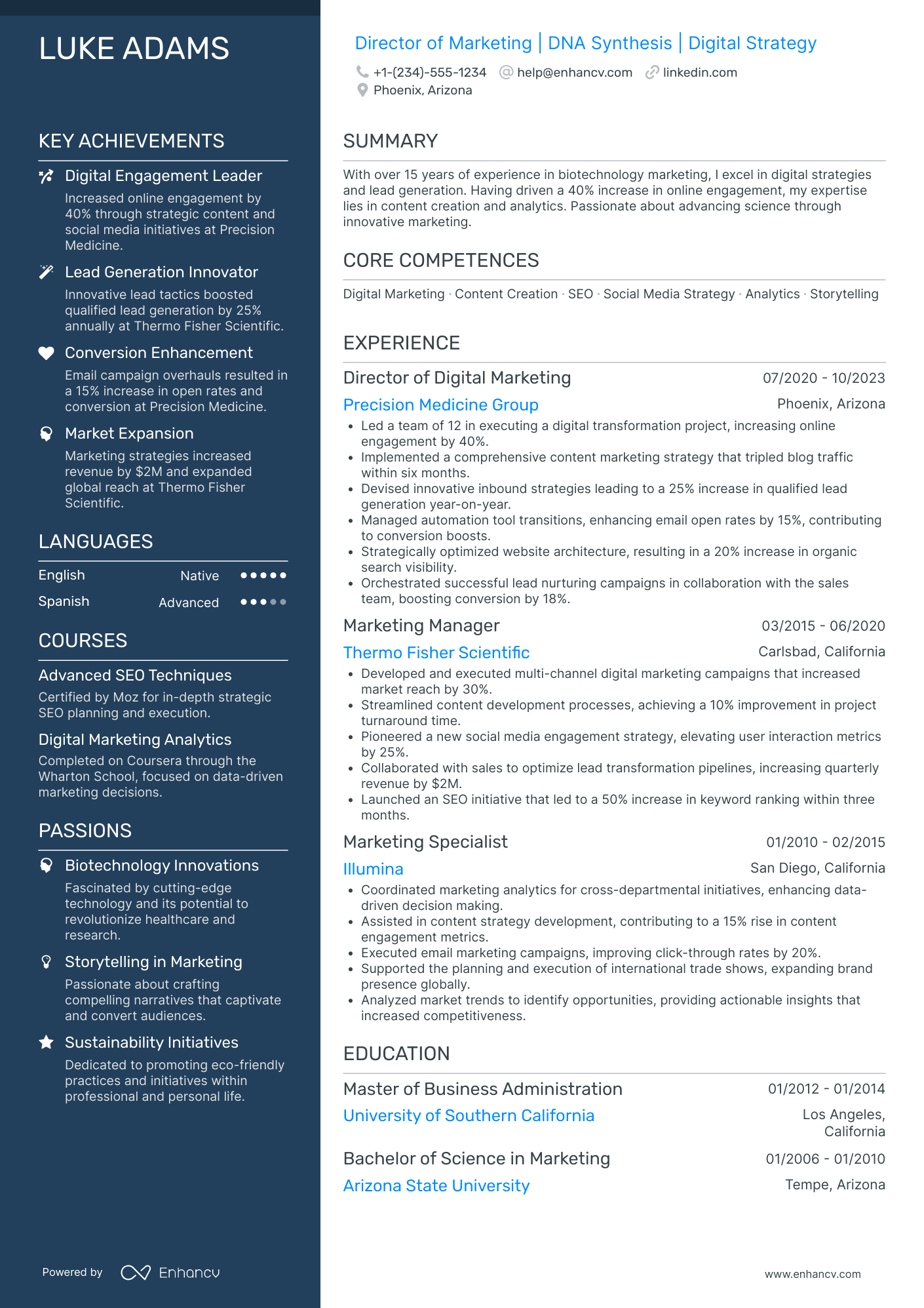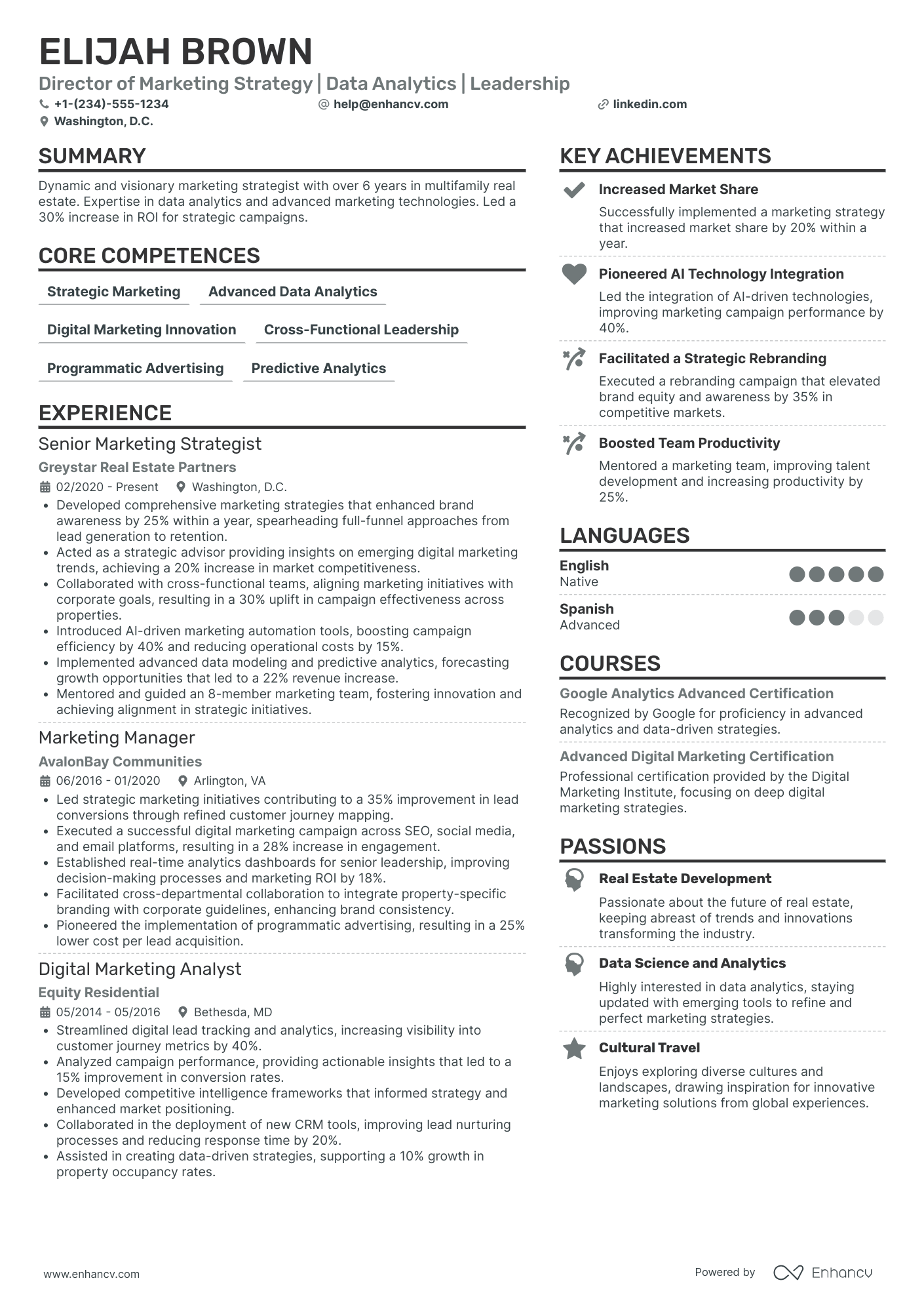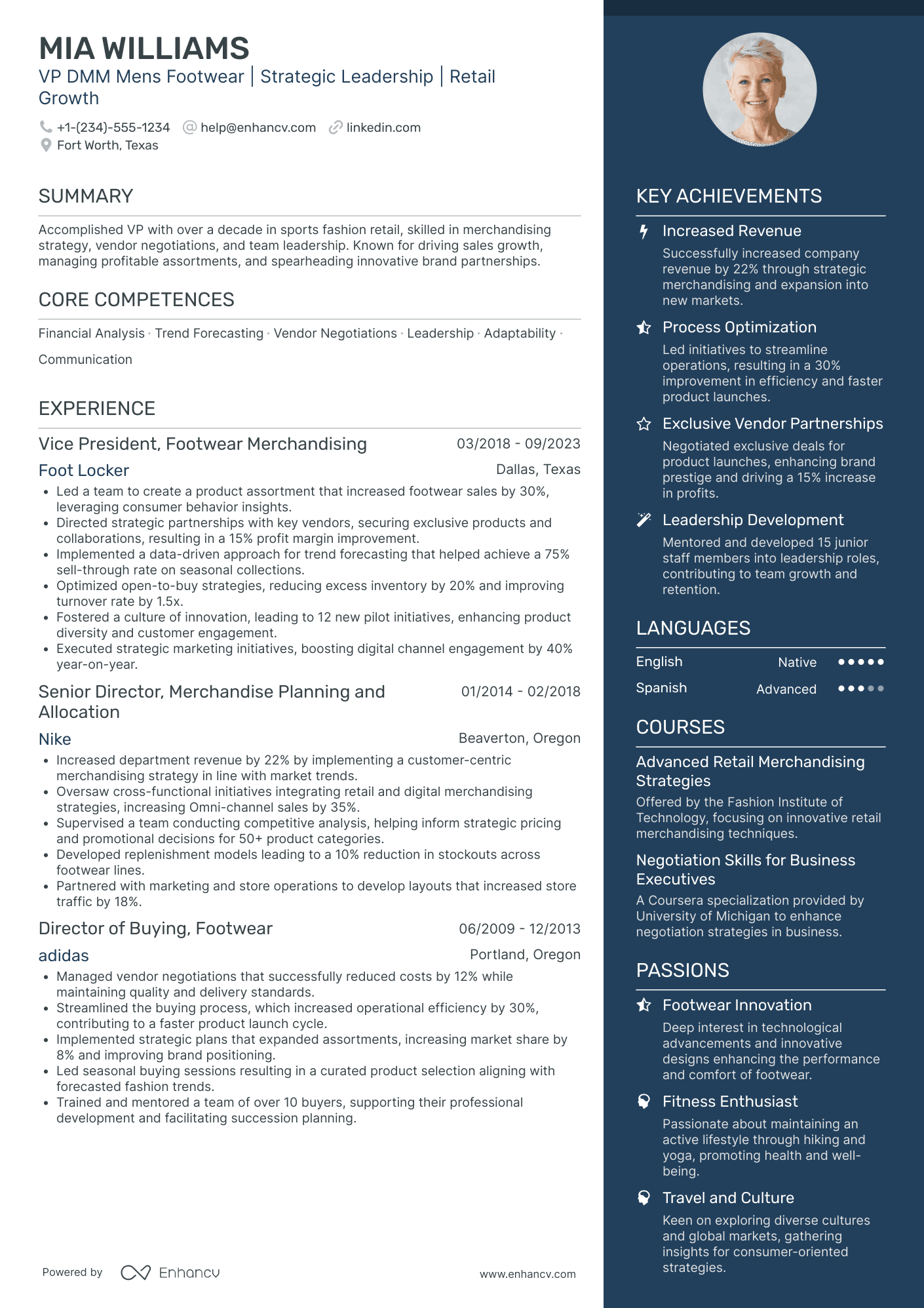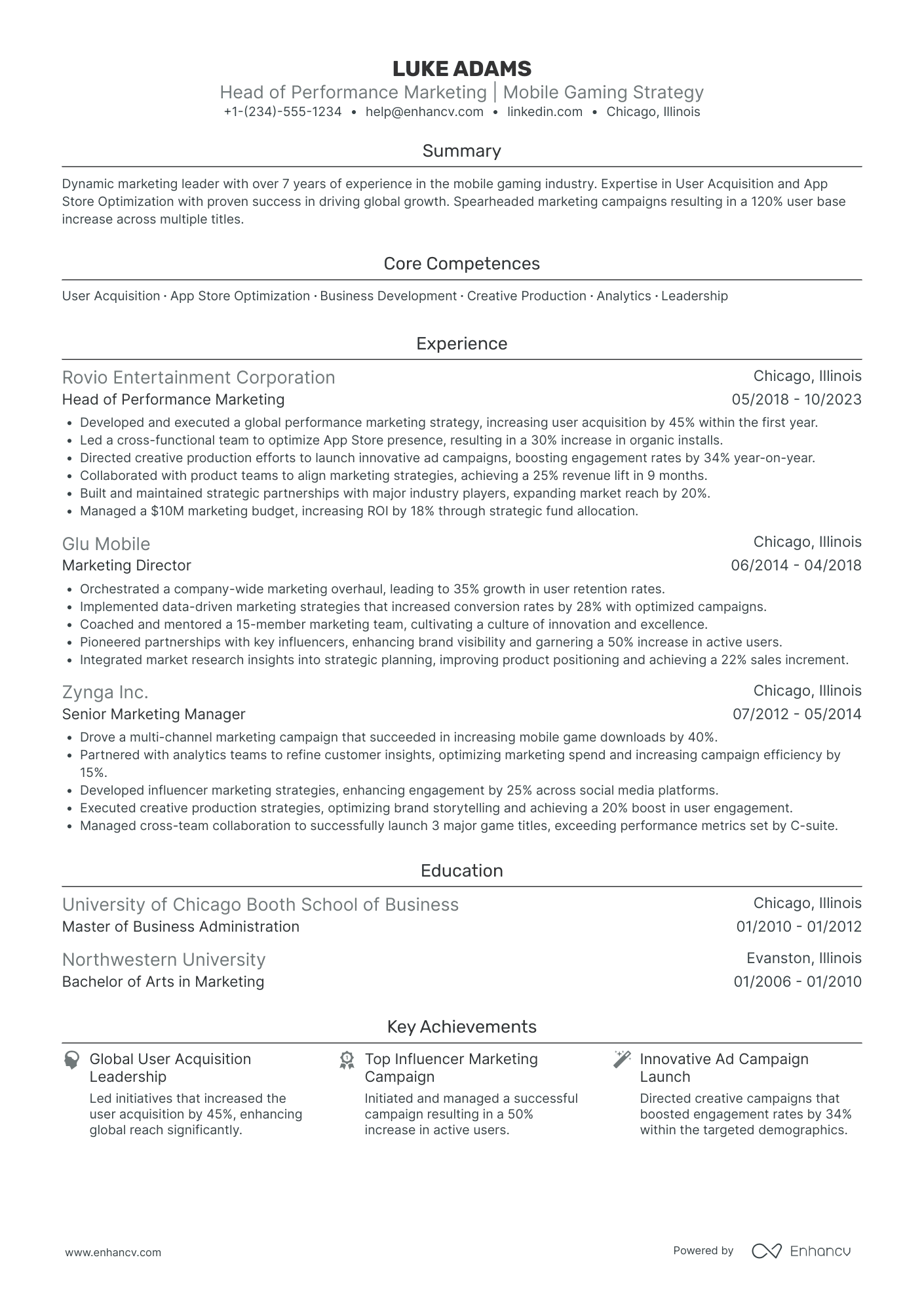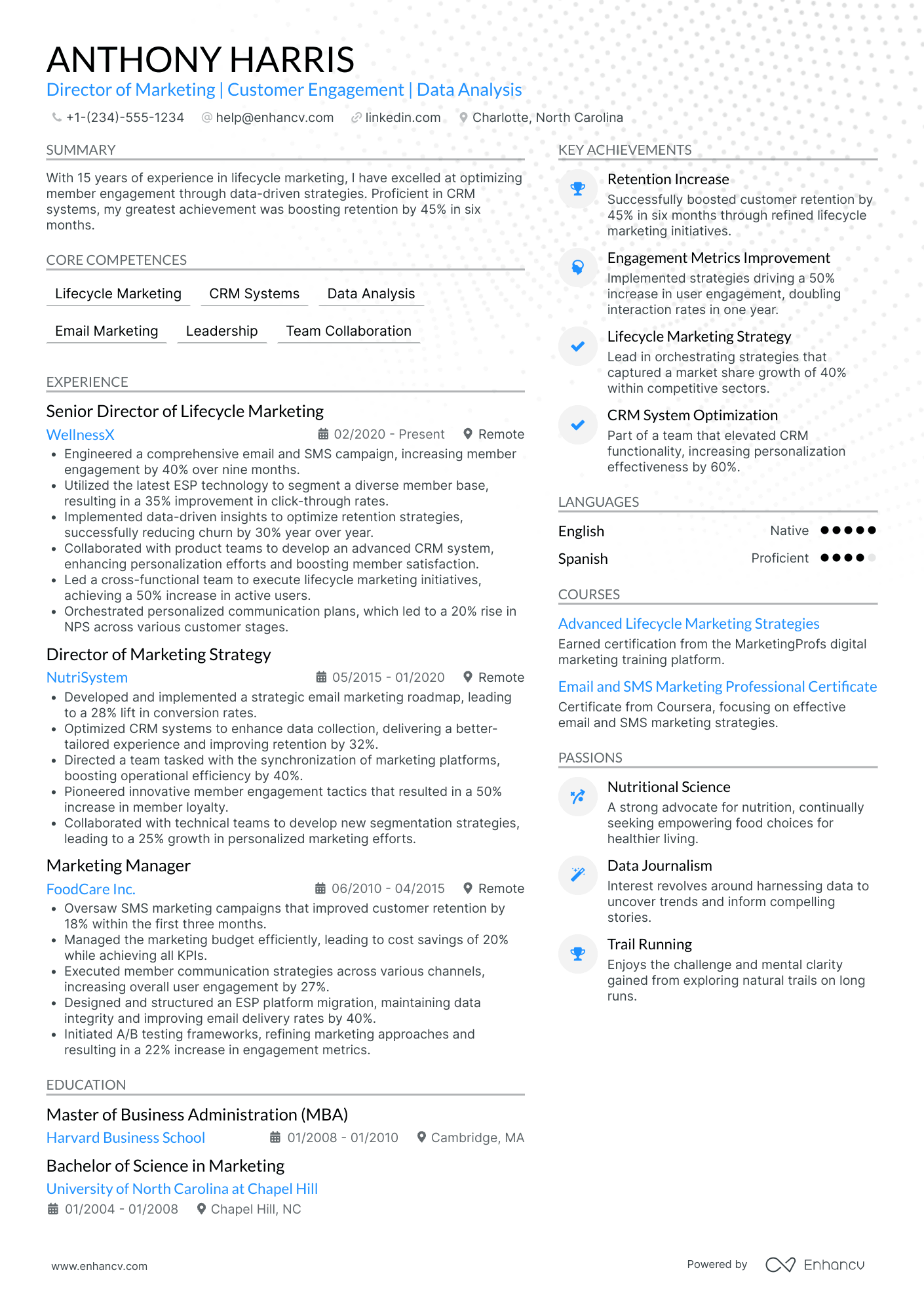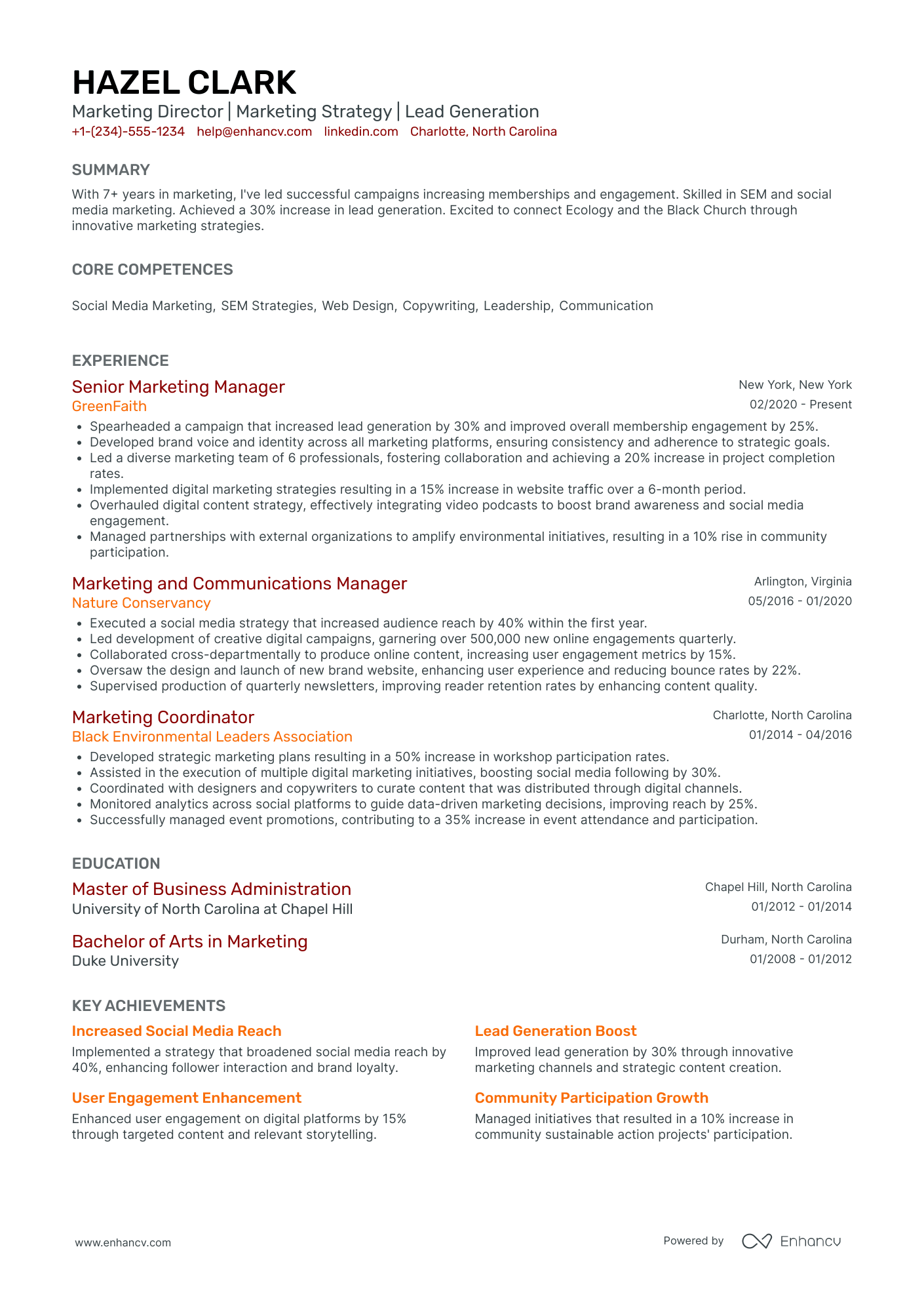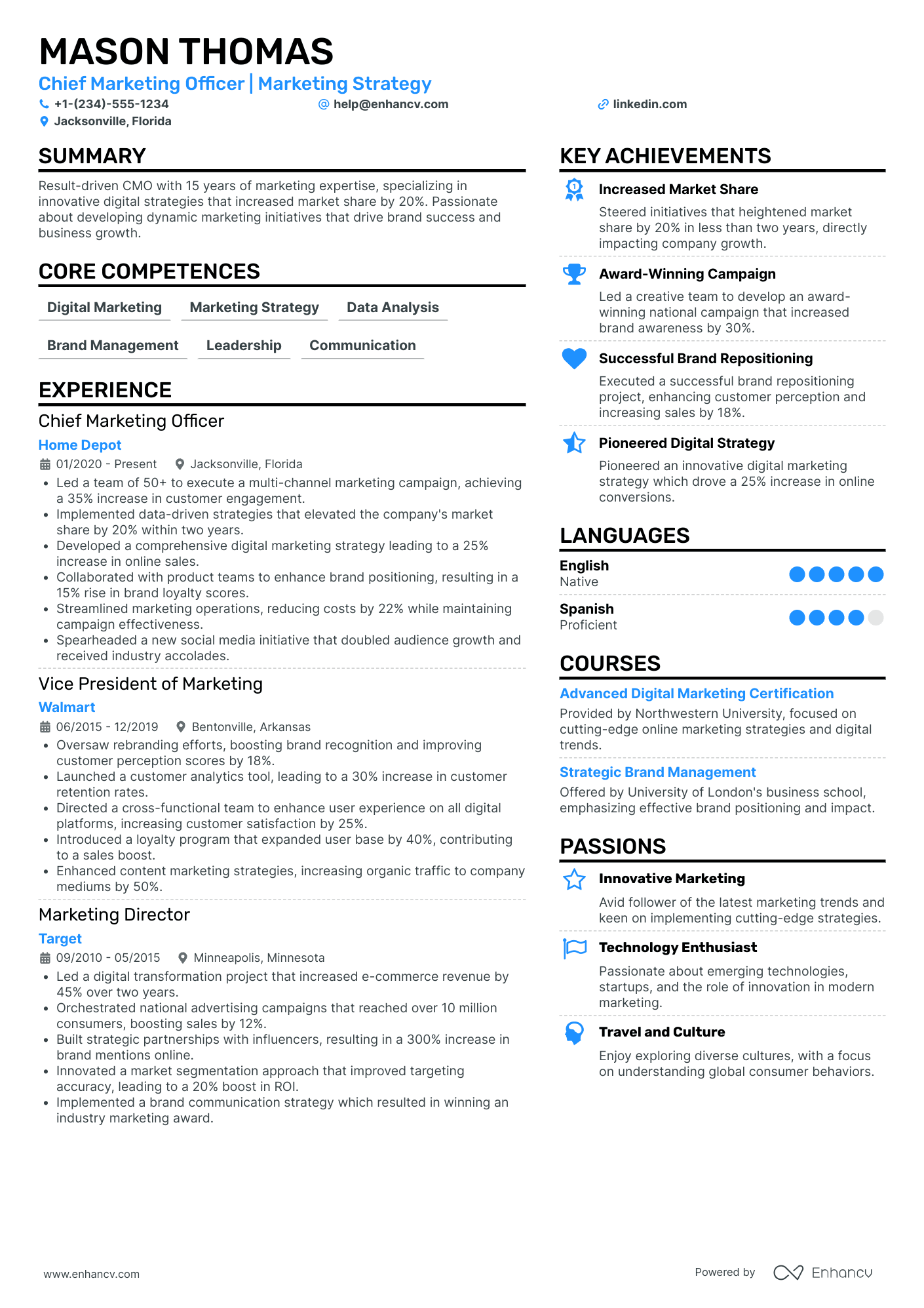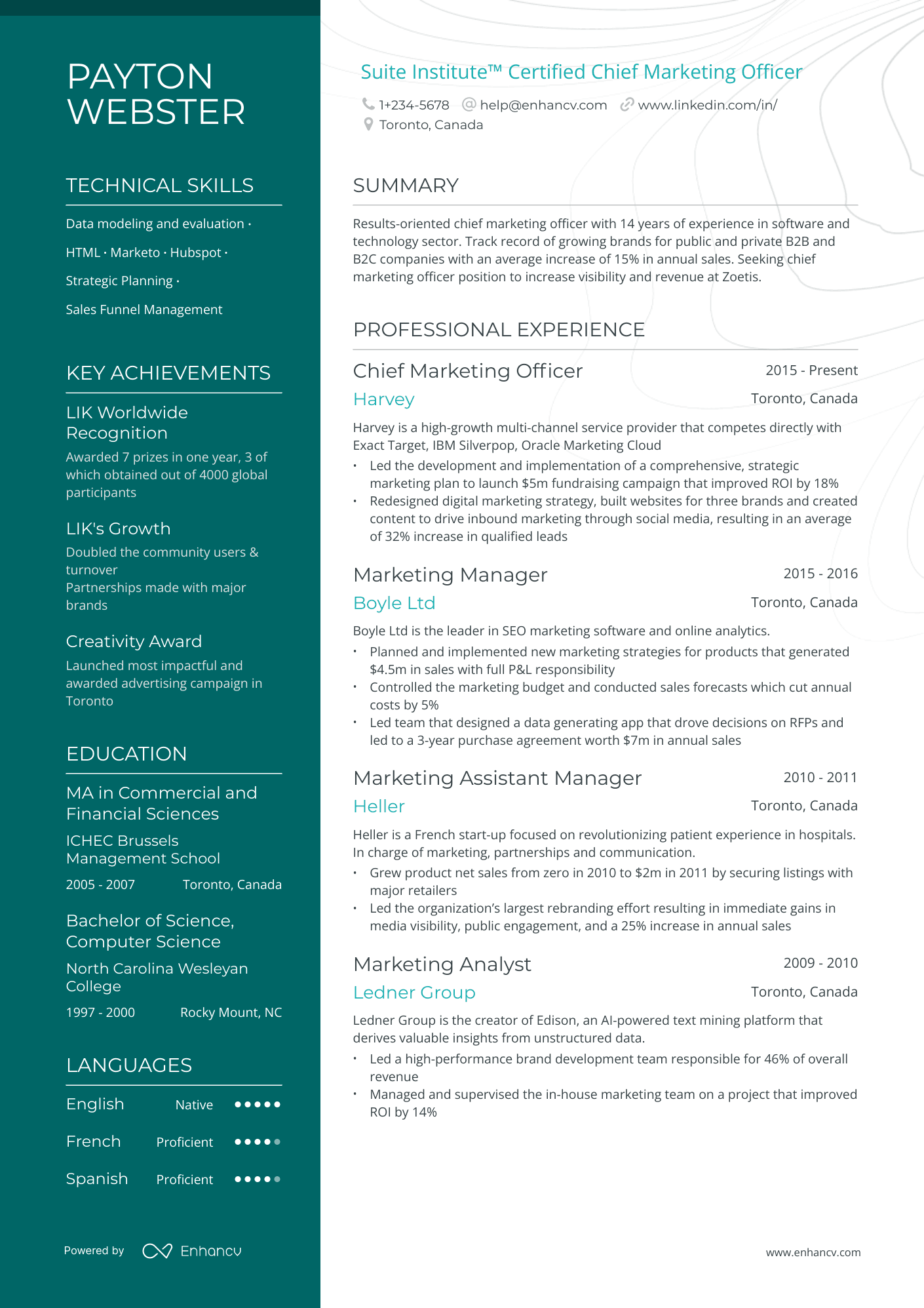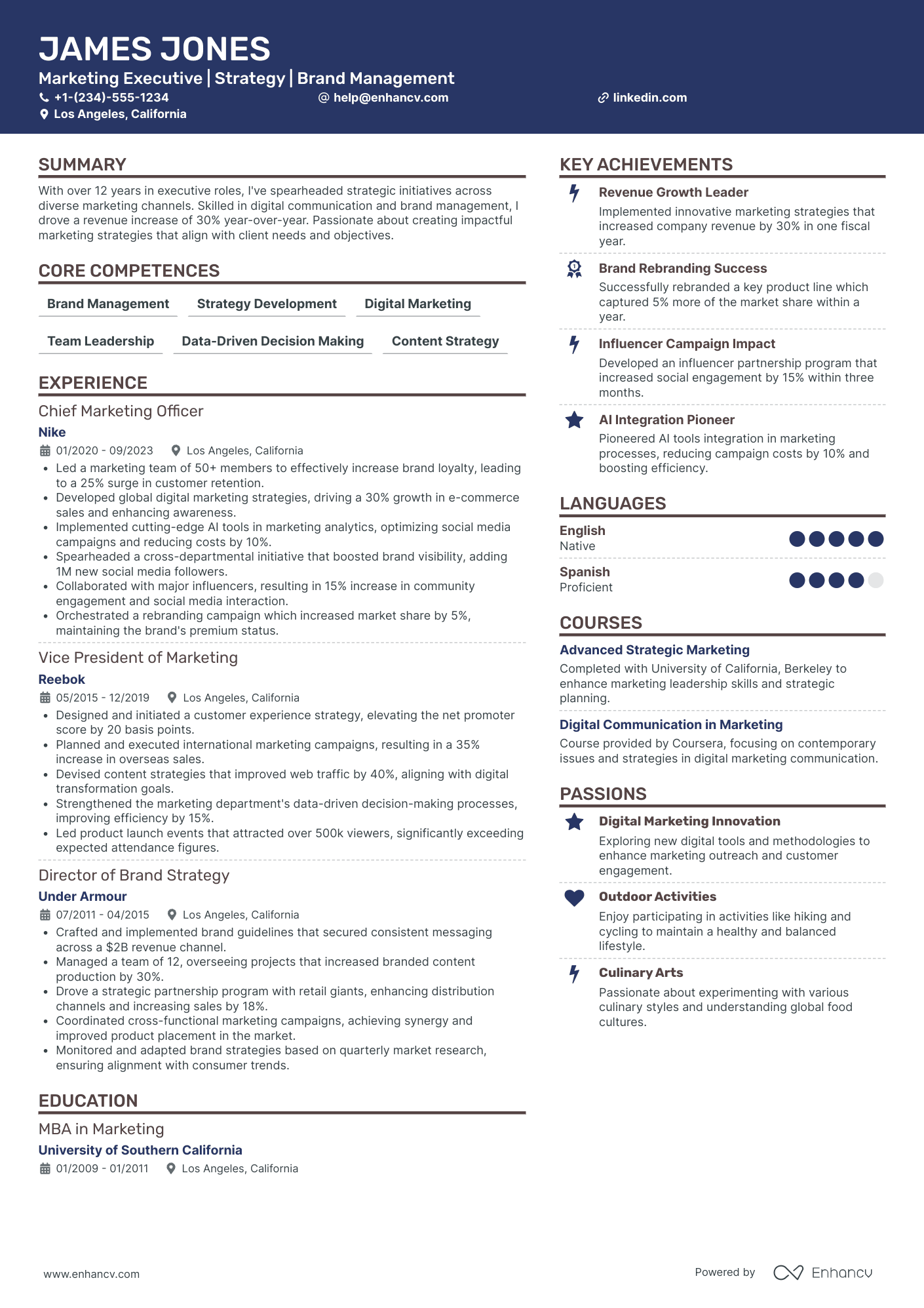As a CMO, you understand the value in a clear objective and strong marketing strategy. You’ve applied these principles and achieved financial and branding goals.
Now you’ve got a new product to market - your CMO resume!
It’s time to apply that entrepreneurial spirit to writing a great chief marketing officer resume and make yourself irresistible to recruiters.
Here’s what this guide will help you with:
- How to group your past roles experiences into themes that show your forward-thinking strategies.
- Listing standout skills like digital marketing mastery and stakeholder engagement without making your resume too long.
- Highlighting key achievements, from brand growth metrics to industry accolades, using result-oriented bullet writing.
- Showcasing thought leadership through custom sections like publications and major conference engagements.
In case you’re looking for other executive marketing jobs, you can check this list:
Let’s dive in!
Cmo resume example
- Specialized Certifications: Highlighting niche certifications such as the "Suite Institute™ Certified chief marketing officer" immediately showcases the applicant's expertise in the field of marketing. Also, additional certifications like "Google Ads Certificate" and "Hubspot Inbound Marketing Certificate" demonstrate a commitment to keeping skills updated and relevant in the digital marketing sphere.
- Quantifiable Achievements: Throughout the resume, measurable results are evident in various roles, such as "an average increase of 15% in annual sales," "improved ROI by 18%," and "32% increase in qualified leads." Emphasizing such quantifiable accomplishments demonstrates the direct impact the applicant has had in their previous roles.
- Technical Skills: Listing specific technical skills relevant to marketing, such as "Data modeling and evaluation," "Marketo," and "Hubspot," illustrates the candidate's hands-on experience and proficiency in using tools essential to the role.
- Unique Value Proposition: Under "KEY ACHIEVEMENTS," the candidate has highlighted awards and recognitions, such as "LIK Worldwide Recognition" and "Creativity Award." These are testament to the candidate's creativity, innovation, and ability to stand out in the marketing field.
How to format a cmo resume
Every section of your CMO resume needs to convey that you are a marketing professional and a good leader. To achieve this, here are a few things to keep in mind:
- Think of yourself as the product, your resume as the marketing channel, and the hiring manager as your target audience.
- Find your unique value proposition as a CMO. Then promote it throughout different sections in your resume.
- Don’t sell yourself as a generalist. Instead, combine what you want to achieve with what the job requires to find a unique voice to communicate in.
- Do some reflecting on your previous roles. Think about how your expertise has helped former employers. What goals did the company achieve because of your input? How did you identify and engage a target audience?
All of this important information has to be presented in a way that is clear, concise, and engaging. Each section of your resume should follow these guidelines with no wasted space.
Targeting Canada? – Keep in mind their resume layout may differ from others.
Is your resume good enough?
Drop your resume here or choose a file. PDF & DOCX only. Max 2MB file size.
The top sections on a CMO resume:
- Executive Summary: A concise overview of leadership style, accomplishments, and vision.
- Professional Experience: Details tenure, achievements, and impact in previous CEO or executive roles.
- Board Memberships and Affiliations: Highlights leadership experience and industry involvement.
- Education and Professional Development: Emphasizes formal qualifications and ongoing executive training.
- Awards and Recognitions: Demonstrates peer and industry acknowledgment of executive excellence.
What recruiters want to see on your resume:
- Demonstrated history of company growth or successful turnarounds.
- Experience in strategic planning and vision setting for the organization.
- Ability to build, lead, and mentor high-performing teams.
- Strong external relations with stakeholders, including investors, partners, and regulators.
- Proven skills in risk management and navigating complex business challenges.
Depending on your experience and the role you’re applying for, there are specific formatting guidelines to make the most of your resume layout:
- Reverse Chronological Format: For a chief marketing officer (CMO) resume, the reverse chronological format remains the most recommended. This layout allows you to showcase your journey, starting perhaps as a marketing executive or coordinator, progressing to managerial roles, and finally attaining the pinnacle as a marketing director or a CMO. This format not only gives an overview of your accomplishments but also provides a storyline of your rise in the marketing world.
- Header: The header of your CMO resume is your first impression. Ensure it's clean, professional, and includes vital contact details. While some professionals opt to include a professionally taken photo, it's not mandatory and may be omitted depending on the cultural norms or preferences of the country or company you're applying to.
- Length of Resume: Given the breadth and depth of experiences and accomplishments a CMO might have, it's tempting to make the resume lengthy. However, it's crucial to maintain conciseness. Aim for 1-2 pages, with two pages being more common for those with extensive experience. Be selective about the achievements and roles you highlight, prioritizing those most relevant to the position you're applying for.
- What File Format to Use: A PDF file format remains the top choice for submitting resumes. The consistent format ensures that your resume appears the same on any device or platform. However, if a different format is explicitly requested by the employer, follow their guidelines. Remember, always proofread and test your document before sending to ensure that formatting remains consistent.
How should you frame your chief marketing officer resume experience?
The complexity of a CMO’s career can be a gift and a curse when it comes to resumes. From developing strategies for an excellent customer experience to selling millions of products, it can be hard to choose what bullets to include.
Don’t make the mistake of cramming as many accomplishments as you can into your resume. Assuming you’ve had a long career so far, doing so will result in a 5-page-long resume that nobody will finish reading.
Part of what makes you an executive is your ability to prioritize and make important decisions. You’ve got to do the same for your resume content, too.
Not every task you’ve accomplished is relevant to every chief marketing officer role.
Your experience section needs to be tailored specifically to show that you can:
- Handle high-level metrics such as branding and lead generation
- Work with individuals from different departments with different positions in the company
- Lead teams of different sizes and efficiently delegate responsibility for execution
- Conduct in-depth analysis and measure ROI and marketing spending.
Let’s take a look at a few CMO resume experience section examples.
- •Responsible for consumer acquisition and retention marketing
- •Rebuilt company sales by developing a new customer acquisition strategy
- •Led and executed comprehensive communication and brand strategy.
The bullets above give the impression that the candidate copied and pasted them directly from a chief marketing officer job description.
They are not personalized at all and show no specific achievements.
Let’s tweak it a little bit by adding specific details on past roles and accomplishments.
- •Led and supervised a global marketing team of colleagues and senior marketing professionals.
- •Implemented 3 new marketing campaigns each year that resulted in an annual growth of 6% on average.
- •Built new digital ad spending strategies that improved ROIs by 27% within 24 months.
- •Established a new pet care customer base that brought in an additional $7M in sales to revenue stream.
What works in this example:
- Specific stats and achievements are used
- Shows job-specific skills and industry knowledge
This is detailed enough for recruiters to get a good impression of you and for hiring managers to imagine you helping their company
Let’s take a look at one more that shows the other duties of a chief marketing officer.
- •Set new branding and marketing strategies that increased brand visibility by 43%.
- •Participated in research to come up with new product ideas and growth strategies that resulted in a 9% increase in revenue.
- •Managed and supervised the in-house marketing team on a project that improved ROI by 14%.
- •Planned and implemented new marketing strategies for products that generated $4.5m in sales.
- •Controlled the marketing budget and conducted sales forecasts which cut annual cost by 5%.
This example includes specific achievements and statistics just like the one above.
Look at your target job description and decide what CMO duties hiring managers want to see. Select your own accomplishments with that in mind.
How to quantify impact on your resume
Numbers on resume are impressive, but how do you know which ones recruiters are looking for when it comes to CMOs? Let’s look at a few effective example scenarios:
- Include annual marketing budget managed: Demonstrates financial responsibility and the scale of operations overseen.
- Quantify the percentage growth in brand visibility or recognition: Shows effectiveness in building brand awareness.
- Highlight conversion rate improvements: Indicates expertise in funnel optimization and sales growth.
- List the increase in social media followers or engagement rates: Displays effectiveness in digital and social media strategies.
- Mention the percentage of customer retention achieved: Emphasizes ability to maintain and nurture customer relationships.
- State the ROI on major marketing campaigns: Demonstrates your focus on profitable strategies and fiscal accountability.
- Detail percentage reductions in marketing costs, if any: Shows efficiency and the ability to optimize resources.
- Include growth rates of email or subscriber lists: Reflects success in content and inbound marketing efforts.
Which hard skills and soft skills to showcase on your resume
A lot of what you do as a chief marketing officer is data, strategy, and people-oriented.
Your role requires you to work with lots of different teams within the company. Therefore, you have to be both a leader and a team player at the same time.
This requires a strong foundation of soft skills.
To be a successful CMO requires the willingness to be a good partner with the rest of the organization… They have to be adaptable to change and always keep learning new things… And most importantly, a successful CMO has to be a business leader first and then a marketing leader.
Tariq Shaukat, EVP and CMO, Caesars
Having spent the beginning of your career in marketing, you’re probably confident in naming your technical skills.
At C-Suite level positions, your soft skills are what you really want to make shine.
Again, it’s best to be selective when choosing what soft skills to include on you CMO resume. You may feel confident in dozens, but recruiters will be looking for the ones most specific to the job.
Be sure to back them up with supporting evidence in your experience section. Recruiters won’t just take your word for it.
For example, “Led marketing strategy on a product launch that won ‘2020 Most Creative Launch’ award” is much more impactful than simply listing “Creative thinker” in your list of skills.
Here are a few more soft skills to consider adding to your CMO resume.
Best soft skills for your CMO resume
- Leadership
- Strategic Thinking
- Communication
- Team Management
- Adaptability
- Problem-solving
- Emotional Intelligence
- Creativity
- Decision-making
- Collaboration
- Networking
- Negotiation
- Time Management
- Persuasion
- Analytical Thinking
- Visionary Approach
- Resilience
- Stakeholder Engagement
- Ethical Judgment
- Conflict Resolution
As for the technical skills, adding them to your CMO resume is a bit more straightforward.
Tailor your list to your target job. You might have experience with dozens of automation tools and design software, but you should focus on the ones most relevant to the company
Save space and leave out technical skills that are expected. For example, every CMO applying to this job knows how to use Microsoft Office (We’ve actually seen executives do that). No need to include it on your resume.
Here are a few technical skills to consider for your CMO resume.
Best hard skills for your CMO resume
- Digital Marketing
- Brand Development
- Marketing Automation Platforms (e.g., HubSpot, Marketo)
- Content Creation & Management
- SEO & SEM
- Data Analytics & Reporting
- CRM Software (e.g., Salesforce)
- Social Media Marketing
- PPC Advertising
- Email Marketing
- Affiliate Marketing
- Mobile Marketing
- Video Production & Editing
- A/B Testing
- UX/UI Principles
- Budget Management
- E-commerce Strategies
- Influencer Partnerships
- Public Relations Management
- Event and Trade Show Marketing
How to list your certifications and education on your resume
Struggling to highlight certain aspects of your experience throughout your resume?
This section is your savior.
Most job applications state clearly what the job requires you to do.
Getting a certification is a genuine way to show your interest in the job and draw attention to your high ambitions for the position.
It’s also a great way to stay on top of industry trends and explore areas you may not have as much experience.
Top 11 certifications for your CMO resume
- AMA Professional Certified Marketer
- AMA® Certificate in Analytical Skills
- Adobe Certified Expert (ACE)
- Hubspot Inbound Marketing Certification
- Hootsuite Social Media Certification
- The Digital Marketing Institute Certified Digital Marketing Professional
- Google’s Digital Garage: Fundamentals of Digital Marketing Certification
- Online Marketing Certified Professional (OMCP)
- Cornell University Digital Marketing Certificate Program
- American Marketing Association’s Digital Marketing Certification
- Certified ScrumMaster
For more information on how to properly list resume certifications, we recommend reading our guide How To List Certifications On A Resume (Examples Included).
Chief marketing officer resume summary’s tips and recommendations
We recommend writing your resume summary at the end. This way, you’ll be able to take into account the important information you already have, and summarize it at the top.
The goal of the summary is to convey your value in the industry and show potential employers what you will bring to the company. A concise and engaging summary will encourage them to keep reading. Here’s what recruiters will be happy to see:
- A key skill of great CMOs is quality copywriting. Your summary is an opportunity to show employers how you would craft persuasive web copy, white papers, product descriptions, and blog posts.
- The best chief marketing officers today are results-oriented. Make your point by showcasing previous winning campaigns and products.
- Be mindful of avoiding filler words and use action verbs supported by concrete numbers such as ROI, sales revenue, website conversion rates, etc.
- As a CMO, you have spent years in the industry and likely have a collection of stats to choose from. Look into your target job and find their biggest company challenge. Your summary should show how you will solve it.
Let’s take a look at a few CMO resume summary examples.
There is some debate across industries as to whether “I” belongs in a summary. As a chief marketing officer, you will be leading teams. Starting with “I” gives the impression that everything that follows will be all about you.
Recruiters want to know how you guide teams to test and improve strategies. Show how you will help your future employer, not just yourself.
This example also includes the blanket term “hard-working.” This word doesn’t mean anything specific and can be interpreted in a number of ways.
Some companies expect a “hard-working” CMO to work long hours or anything else necessary for the company to thrive.
Be clear in your choice of words and always use concrete, specific numbers when referencing things like an increase in revenue or ROI.
This summary also claims that the candidate has “over eight years of experience in marketing” without any supporting evidence. Let recruiters know what you achieved during that time.
If you need help choosing an achievement, try asking yourself the following questions:
- What business and marketing aspects were you in charge of during that time?
- Did you have any successful marketing campaigns?
- Were you responsible for any successful products?
- Did you receive any positive feedback from your customers?
Let’s look at a summary that gets it right.
This summary has everything an amazing CMO summary needs.
Let’s look at what it achieves:
- States some of your most important past accomplishments
- Features your long years of experience working as a chief marketing officer
- Provides concrete results with precise numbers
- Shows that you’re not mass-sending your resume by mentioning the name of the organization to which you’re applying.
Frame your value proposition around what the new role requires you to do. Feature your marketing and sales skills to emphasize the goals they helped you accomplish.
For more tips and guidance on crafting a great CMO resume summary, check out our guide Resume Summary: How-To Guide (30+ Examples You Need To See).
Optimize your resume summary and objective for ATS
Drop your resume here or choose a file.
PDF & DOCX only. Max 2MB file size.
Additional sections for a cmo resume
Depending on the company, there may be additional skills and experiences that separate you from other candidates. Sometimes the standard sections just aren’t enough to show why you’re the perfect CMO for the job.
If your target company has international offices or markets to an international audience, including language skills can be a big advantage.
Things like projects, volunteer work, and hobbies and interests are a great way to show you are passionate about things that are relevant to the job. For example, applying for a position at an animal health agency and including your volunteer experience at your local animal shelter.
To wrap this up, let’s mention the references section. References are important in the executive world - especially when it comes to confidential information, you will need someone to back up or elaborate on your statements.
Key takeaways for creating the best chief marketing officer resume
- Create a resume specifically tailored to the chief marketing officer role
- Use your summary as a brief introduction to showcase your sales and marketing skills
- Highlight your successful campaigns and brilliant marketing ideas throughout your resume
- Use precise numbers to prove your competence in understanding customers and creating winning products
- Use certifications to authentically turn your career shortcomings into strong selling points
Chief Marketing Officer resume examples
By Experience
Junior Chief Marketing Officer
Senior Chief Marketing Officer
Global Chief Marketing Officer
By Role
Global Chief Marketing Officer
- Comprehensive Career Progression - Sophia's resume outlines a clear upward trajectory in the marketing field, advancing from a Marketing Manager role to senior positions like Head of Marketing. Her career has progressed across different companies and locations, demonstrating a successful climb marked by increased responsibilities and leadership opportunities.
- Strategic Utilization of Digital Tools - The resume highlights her adept use of industry-specific digital marketing tools such as Google Ads and Meta Ads. These skills are complemented by implementation strategies for analytics tools and SEM/SEO methodologies, showcasing technical depth that supports data-driven decision-making and successful marketing campaign execution.
- Impactful Achievement Narration - Sophia effectively frames her achievements with both numerical outcomes and their business relevance. For instance, she not only mentions a 25% increase in membership growth but also ties it to strategic digital marketing initiatives. This approach ensures her contributions are articulated with clear business impact, enhancing her profile as a results-oriented professional.
Chief Marketing and Sales Officer
- Structured and clear content presentation - The resume is well-organized, with distinct sections dedicated to experience, education, skills, achievements, and passions. Each section uses bullet points for concise storytelling, improving readability and allowing key information to stand out, such as Michael Martinez's sales growth and leadership roles.
- Consistent career growth and industry expertise - Michael's career trajectory showcases a successful path within the luxury multimedia publishing industry, consistently progressing from a Business Development Associate to Senior Sales Executive. This demonstrates not only growth in responsibility but also a deepening expertise in sales and client management within a specific sector.
- Quantifiable achievements with significant business impact - The resume effectively highlights achievements that are both quantifiable and impactful. Michael increased regional sales revenue by 35% and expanded the client base by 50%. These accomplishments underscore his business acumen and ability to implement strategies that directly contribute to the organization's bottom line.
Chief Marketing and Communications Officer
- Emphasizes Strategic Leadership - The resume effectively showcases the candidate's strategic leadership capabilities through their role progression, culminating in a Chief Marketing & Communications Officer position. This trajectory highlights the candidate’s capacity to shape and direct entire marketing departments, illustrating their ability to influence institutional marketing strategies on a macro scale.
- Integrates Cross-Functional Experience - The document thoroughly outlines the candidate’s ability to collaborate across functions, as seen in their work coordinating with cross-functional teams for successful event execution at United Way of King County. This adaptability indicates their capacity to work effectively within diverse operational environments, fostering partnerships that enhance outcome efficiency.
- Underscores Impactful Achievements - Achievements are presented with business relevance, going beyond mere statistics to demonstrate meaningful social impact. For instance, the candidate’s work at The Salvation Army realized over $2 million annually through strategic fundraising, reflecting considerable financial contributions to organizational sustainability and community betterment.
Regional Chief Marketing Officer
- Structured and Targeted Content Presentation - The resume is organized with precision, clearly defining each section and maintaining consistency in formatting. It succinctly presents James Jones’s qualifications, experience, and skills, making it easily navigable for recruiters looking for specific information pertinent to the marketing field.
- Impressive Career Trajectory and Growth - James's career progression from Senior Marketing Manager to Head of User Acquisition demonstrates a clear upward trajectory. His experience with prestigious companies like Rovio Entertainment and Electronic Arts highlights his ability to adapt and excel in different roles within the gaming industry, showing his capacity for leadership and strategic growth.
- Industry-Specific Expertise and Innovations - James has leveraged multi-channel marketing strategies within the mobile gaming industry, demonstrating a deep understanding of user acquisition and app store optimization. His focus on data-driven marketing and performance improvement showcases his technical and strategic prowess, setting him apart in a competitive sector.
Chief Marketing and Strategy Officer
- Focused Leadership in Strategy and Communication - David Clark's resume expertly conveys his abilities as a strategic leader with extensive experience in utility industries. The document emphasizes his role in directing large teams and driving significant improvements in market position and brand recognition, showcasing his impact on business strategy and communication.
- Broad Experience Across Functions and Industries - The career trajectory highlights a well-rounded progression from communications to executive strategy roles in major utility companies. This shift underscores his growing influence and capability in navigating complex industry environments and regulatory frameworks.
- Impressive Track Record of Tangible Achievements - His accomplishments are robustly supported by quantifiable results, such as a 25% market share increase and $5 million in cost savings. These metrics are not just numbers; they reflect substantial strategic foresight and execution prowess that directly contributed to organizational growth and efficiency.
Chief Content Marketing Officer
- Strong career trajectory with leading firms - John Walker's career progression from Content Marketing Manager at Adobe to a Senior Marketing Manager at Shopify reflects significant growth in responsibility and expertise. His steady rise through renowned companies like Google Ads showcases a commitment to advancing in the marketing field while gaining diverse industry insights.
- Impressive use of strategic methodologies - The resume conveys adept usage of industry-specific methodologies such as customer journey mapping and A/B testing. His focus on content discoverability and omni-channel marketing strategies reflects a deep understanding of the tools and processes essential to driving engagement and conversion in today's digital landscape.
- Exceptional focus on cross-functional collaboration - John's ability to collaborate closely with product management and other internal teams highlights his adaptability and effectiveness in driving cross-functional initiatives. By aligning marketing strategies across departments, he's demonstrated a clear capacity to foster cohesive and impactful enterprise-wide projects.
By Industry
Chief Marketing Officer in Retail
- Content presentation through structured clarity - The resume employs a clear structure that allows easy navigation through various career segments. The concise bullet points under each job role facilitate quick comprehension of accomplishments and responsibilities, ensuring that key achievements are highlighted without overwhelming the reader.
- Impressive growth acknowledgment in career trajectory - Alexander Taylor’s career trajectory is marked by consistent upward growth, with notable promotions from Marketing Manager to VP roles at leading companies. This progression highlights his ability to adapt and excel within different organizational cultures while expanding his leadership scope and responsibilities.
- Unique methodologies and creative industry strategies - The resume underscores unique industry-specific elements such as implementing innovative loyalty programs and optimizing creative media strategies. These approaches denote a deep understanding of retail marketing and an ability to leverage modern marketing techniques effectively to drive results.
Chief Marketing Officer in Technology
- Comprehensive Career Growth - Joshua Nelson's career trajectory is impressive, showcasing a clear path of growth through major industry players like Warner Bros., Paramount Pictures, and Universal Pictures. Starting from a Senior IT Manager to become Senior VP, it underscores his adaptability and rising expertise in media and IT strategy.
- Effective Leadership and Relationship Building - The resume highlights Nelson's ability to lead cross-functional teams, manage vendors, and foster global partnerships. His leadership in steering projects that significantly enhance operational efficiency and revenue is a testament to his capacity to inspire teams and drive organizational success.
- Robust Industry-Specific Expertise - Nelson's expertise in aligning technology with business objectives through cloud solutions, cybersecurity measures, and data analytics signifies a deep understanding of technical tools and methodologies specific to the media industry. This is crucial for advancing digital transformation initiatives.
Chief Marketing Officer in Finance
- Clear and Structured Presentation - Ava Johnson's resume is structured for maximum clarity, with distinct sections such as career summary, experience, education, and skills. The conciseness is evident as each job role is supported by impactful bullets, providing a quick yet comprehensive understanding of responsibilities and achievements.
- Impressive Career Trajectory and Industry Expertise - The resume showcases a notable career progression from Senior Financial Analyst to VP Finance. This advancement highlights her leadership capabilities across different tech giants like Intuit, Salesforce, and Docusign, underscoring her expertise in the SaaS and tech sectors.
- Achievements with Tangible Business Impact - Ava’s achievements emphasize not just outcomes, but their strategic effects on business. Her contributions to increased sales by $150M and cost reductions align with broader financial goals, demonstrating her ability to leverage data for substantial company growth and efficiency.
Chief Marketing Officer in Manufacturing
- Clarity and Structured Presentation - The resume is presented with exceptional clarity and structure, enabling easy navigation and readability. The use of bullet points effectively conveys tasks and achievements succinctly, preventing information overload. Each section is well-defined, providing a comprehensive overview without overwhelming the reader.
- Career Growth and Consistency - Jack’s career trajectory reflects steady growth and increased responsibility, consistently within the administrative and office coordination industry. Transitioning from roles like Administrative Coordinator to Administrative Assistant at major companies, such as Nationwide Mutual Insurance, underscores his ability to adapt and excel in diverse environments while maintaining a focus on office efficiency and executive support.
- Achievements Translating to Business Impact - This resume stands out by quantifying achievements that demonstrate clear business impact. By highlighting improvements such as a 25% reduction in booking conflicts and a 45% increase in data retrieval speed, these accomplishments underscore Jack’s ability to drive meaningful changes that enhance organizational productivity and efficacy.
Chief Marketing Officer in Media & Entertainment
- Exceptional career progression and leadership - Elijah Brown's career trajectory demonstrates remarkable growth, from a Marketing Specialist at Universal Music Group to the Director of Entertainment Marketing at Sony Music Entertainment. This progression highlights his ability to lead large-scale projects and teams effectively, underscoring his leadership and strategic vision in the entertainment industry.
- Diverse skill set with industry-specific expertise - The resume showcases a strong set of skills particularly relevant to entertainment marketing, such as brand strategy, talent management, and partnership management. Elijah's experience in negotiating high-profile contracts and developing innovative campaign activations further reveals his technical depth in this niche field.
- Impressive achievements with significant business impact - Elijah's accomplishments are not just about the numbers; they represent substantial business impacts. For instance, he led a digital engagement campaign that increased consumer interaction by 40%, directly enhancing brand visibility and engagement. Such achievements underscore his ability to deliver results that drive business growth and elevate market presence.
Chief Marketing Officer in E-commerce
- Strategic Content Presentation - The resume's content is arranged in a logical and concise manner, making it easy to navigate and comprehend. Each section is clearly defined, allowing for a quick yet thorough understanding of the candidate's qualifications and strengths. The use of bullet points under experience emphasizes key achievements and responsibilities effectively.
- Progressive Career Trajectory - Christian Torres's career path illustrates significant growth and advancement within the e-commerce marketing field. Starting as a Digital Marketing Analyst, progressing to a Specialist, and ultimately reaching a Senior Manager position, his trajectory highlights a clear upward progression and increasing responsibility, showcasing his capability to adapt and excel in complex roles.
- Industry-Specific Expertise - The resume highlights industry-specific expertise with tools like Google Adwords and GA4 Standards, demonstrating technical depth in paid and organic search marketing. This focus on specialized tools enhances the understanding that Christian is well-versed in employing advanced techniques to improve marketing efficacy and drive business results.
Chief Marketing Officer in Hospitality
- Clear and Structured Presentation - The resume effectively uses concise bullet points under each job role to convey key responsibilities and achievements, making it easy to quickly digest the information. The inclusion of specific percentages and results offers clear evidence of impact, ensuring the reader can quickly gauge the candidate's effectiveness in their roles.
- Steady Career Growth in Marketing - Sebastian's career trajectory is defined by a clear path of growth within the hospitality marketing domain, advancing from Marketing Manager to Director-level roles across major hotel chains. This progression highlights his ability to take on increasing responsibilities and suggests strong leadership capabilities and industry-specific expertise.
- Strategic Leadership and Mentorship - An impressive aspect of the resume is the emphasis on Sebastian's leadership skills, showcasing his ability to mentor and lead sizable teams, resulting in significant productivity boosts. This underlines his capacity to inspire and drive a unified vision across his teams while nurturing individual growth.
Chief Marketing Officer in Automotive
- Comprehensive Career Development - John Walker's resume showcases a well-defined career path with a series of strategic promotions demonstrating progression from Director of Financial Planning at Bank of America to Chief Financial Officer at Goldman Sachs. This career trajectory highlights his consistent growth within industry-leading financial institutions, emphasizing his ability to assume expanding responsibilities and leadership roles.
- Structured Presentation for Maximum Clarity - The resume is neatly organized with distinct sections for experience, education, skills, courses, achievements, languages, and passions. This clear structure ensures that key information is easily accessible and allows the reader to quickly grasp Walker’s qualifications and professional journey, crucial for time-strapped recruiters.
- Emphasis on Strategic Financial Leadership - Walker's achievements are not only quantified in terms of numbers but also contextualized to show business impact. For example, he highlights how his strategic initiatives such as enhancing operational efficiency and spearheading digital transformations led to significant financial and operational improvements, reflecting his visionary leadership in finance.
Chief Marketing Officer in Telecommunications
- Structured Progression in Data Leadership Roles - Riley Nelson's career trajectory is marked by consistent growth and upward mobility, showcasing a successful transition from Director of Data Management to Chief Data Officer. This progression highlights a deepening expertise and increased responsibilities in handling complex data-driven challenges within the technology sector.
- Emphasis on Cross-Domain Expertise - The resume emphasizes Riley's adaptability and cross-functional experience by highlighting collaborations with different departments and stakeholders to deliver comprehensive cloud and data solutions. These experiences demonstrate a robust ability to bridge gaps between technology and business needs, crucial for strategic leadership in tech-driven environments.
- Technological Prowess with Strategic Impact - The resume dedicates significant attention to industry-relevant tools and methodologies such as Amazon Web Services, Data Governance, and AI integration. These elements, combined with substantial percentage-based achievements, underline the practical impact of Riley's expertise in enhancing operational efficiencies and security measures.
Chief Marketing Officer in Pharmaceuticals
- Strategic Leadership and Growth - Sebastian Martin's career trajectory demonstrates a clear pattern of strategic leadership, moving from Product Marketing Specialist to Senior Marketing Director within just a few years. This upward movement indicates his effectiveness in leading teams and directing marketing strategies that result in substantial revenue growth and industry recognition.
- Cross-Functional and Global Collaboration - The roles and responsibilities highlighted in his experience demonstrate strong adaptability and cross-functional collaboration. His capability to align marketing initiatives with sales and R&D teams, along with engaging global stakeholders, indicates a robust understanding of diverse perspectives in driving effective strategies across varying markets.
- Noteworthy Achievements and Their Business Impact - The resume emphasizes key achievements that have pronounced business relevance, such as a 30% increase in product portfolio revenue and a successful product launch strategy, contributing $5M in revenue. These accomplishments highlight Sebastian's ability to deliver impactful results that align with broader business objectives.
Chief Marketing Officer in Nonprofit Organizations
- Consistent Career Progression in Healthcare Marketing - Ethan's career trajectory showcases a clear progression in roles within the healthcare industry, moving from a specialist position at Cleveland Clinic to an executive role at HCA Healthcare. This upward mobility highlights his growing expertise and ability to take on increasing levels of responsibility, demonstrating his readiness for leadership roles in marketing and communications.
- Impact-Driven Achievements Highlight Business Relevance - The resume goes beyond listing achievements by contextualizing their impact on business objectives. For instance, the 30% growth in patient volume and 25% increase in engagement through targeted marketing strategies are not just numbers; they underscore Ethan's capacity to drive significant organizational growth and improve patient interactions through innovative campaigns and leadership.
- Adaptability and Cross-Functional Experience - Ethan's ability to optimize cross-departmental collaboration and manage partnerships with external agencies speaks to his versatility in various facets of marketing and communications. His proficiency in crisis communication, along with his initiatives to train staff and manage budgets, showcases a broad range of soft skills critical for effective leadership within complex organizational ecosystems.
Chief Marketing Officer in Agriculture
- Comprehensive Career Growth - James Jones's career trajectory displays a clear progression through increasingly senior roles in some of the most influential companies such as Nike, Reebok, and Under Armour. This path showcases his ability to adapt and excel within the dynamic landscape of the marketing industry, affirming his readiness for continued executive responsibilities.
- Impactful Achievements with Proven Strategies - The resume emphasizes James's significant contributions to each company's bottom line through strategic marketing initiatives. Highlighting metrics such as a 30% rise in Nike's e-commerce sales and a rebranding campaign adding 5% in market share, these figures illustrate his capability to create impactful strategies with substantial business outcomes.
- Integration of Advanced Marketing Tools - James stands out due to his strategic implementation of cutting-edge AI tools in marketing processes at Nike, which not only optimized social media campaigns but also brought about cost efficiencies. This reflects his proactive approach to leveraging industry-specific methodologies for enhanced marketing performance and decision-making.
Chief Marketing Officer in Energy & Utilities
- Structured Clarity and Conciseness - The resume demonstrates a well-organized layout, providing clarity with concise bullet points under each role. This format makes the candidate's responsibilities and achievements easy to digest, which is crucial for quick scanning by recruiters.
- Career Advancement and Strategic Growth - Owen’s career trajectory is marked by continuous growth, evident by significant promotions from a Regional Sales Director to a Senior Director at Chevron. This trajectory indicates strong performance and capabilities in the gas and NGL marketing industry.
- Industry-Specific Expertise and Tools - The resume highlights Owen’s proficiency with advanced analytics tools and strategic market analyses, indicating deep technical understanding of gas and NGL markets. These skills are critical for adapting to industry changes and optimizing business strategies.
Chief Marketing Officer in Education
- Structured Presentation and Conciseness - The resume is well-organized with clearly delineated sections such as experience, education, and skills, which enhance readability. Each entry is concise, focusing on key achievements and roles, ensuring the document is easy to navigate and informative.
- Impressive Career Trajectory - Ella White's professional journey showcases robust growth from Marketing Communications Manager to Chief Marketing Officer. The trajectory reflects strategic promotions and her capacity to manage larger teams and more complex portfolios, indicating a significant increase in responsibility over time.
- Integration of Modern Marketing Tools - A standout feature of the resume is the integration of advanced industry-specific methodologies, such as AI-driven marketing tools. This highlights her forward-thinking approach and ability to adapt to new technologies that are critical in today's marketing landscape.
Chief Marketing Officer in Sports and Recreation
- Structured for Clarity and Conciseness - The resume is well-organized, presenting sections like experience, education, and skills in a hierarchical format that makes it easy to follow. Each role is supported with precise bullet points that communicate key accomplishments effectively without wordiness.
- Impressive Career Growth and Development - Joshua Nelson's career trajectory showcases an impressive progression from a Digital Marketing Specialist to a Senior Marketing Manager, demonstrating consistent growth within the competitive sports media industry. This upward movement illustrates a dedication to professional advancement and an ability to deliver increasing responsibilities.
- Focus on Cross-Functional Collaboration - The resume highlights Joshua's robust ability to work across departments, leading cross-functional teams to enhance brand visibility. This adaptability is critical for a Marketing Director role and is backed by specific achievements in multinational team environments like Bleacher Report and ESPN.
Chief Marketing Officer in Aerospace
- Structured and Concise Presentation - The resume displays an exceptional ability to present information in a well-organized manner, using clear headings, bullet points, and date ranges. This structure enhances readability, allowing quick access to key details such as achievements, career progression, and educational background.
- Diverse and Progressive Career Trajectory - Alexander Taylor's career path highlights significant growth, transitioning from a Marketing Manager to a Vice President within top aerospace companies. Promotions reflect increasing responsibilities and leadership roles, demonstrating a forward-moving trajectory within the aerospace and digital marketing industries.
- Impactful Achievements - The resume goes beyond listing numbers to expose the business impact of Taylor's contributions, such as a 30% increase in market share and a $25 million boost in annual revenue. These achievements underline the strategic significance of his initiatives, showcasing his ability to influence market trends and corporate growth.
Chief Marketing Officer in Cybersecurity
- Impressive Career Growth - Lucas Rodriguez's journey from Marketing Manager to Director of Marketing showcases a significant upward trajectory. His career reflects progressive roles with increasing responsibility and leadership in industry giants such as Cisco Systems and Palo Alto Networks, illustrating his capacity for professional development and adaptability.
- Integration of Cybersecurity and Marketing Expertise - The resume uniquely blends marketing with cybersecurity, leveraging his role to boost market penetration and enhance brand reputation in a tech-driven industry. This illustrates an in-depth understanding of complex cybersecurity products and the ability to translate technical knowledge into effective marketing strategies.
- Comprehensive and Structured Content Presentation - The resume is clear and well-organized, with distinct sections covering experience, education, skills, courses, and achievements. Each section is concise yet detailed, providing a thorough understanding of his qualifications without overwhelming the reader.
Chief Marketing Officer in Biotechnology
- Strategic Leadership and Team Management - Luke significantly impacted organizational success by leading a team of 12 through a digital transformation, showcasing his strategic leadership and ability to handle large-scale projects efficiently, leading to notable improvements in online engagement and reach.
- Industry-Specific Expertise in Biotechnology Marketing - This resume stands out due to Luke's industry-specific experience in biotechnology. His unique contribution to organizations like Precision Medicine Group and Thermo Fisher Scientific emphasizes both technical and strategic elements in DNA synthesis and healthcare marketing.
- Robust Cross-Functional Experience - The resume clearly demonstrates Luke's ability to adapt and thrive across various roles and companies. His extensive marketing experience from Marketing Specialist to Director of Digital Marketing illustrates his competence in handling diversified roles while maintaining a focus on long-term company goals and adapting to different industry nuances.
Chief Marketing Officer in Real Estate
- Balanced Content Structure - The resume boasts a clean and organized structure, making it easy to navigate through the candidate's qualifications. The use of clear headings, concise bullet points, and comprehensive yet succinct descriptions showcase the candidate's key strengths and accomplishments without overwhelming the reader.
- Progressive Career Development - Elijah's career trajectory demonstrates significant growth, evolving from a Digital Marketing Analyst to a Director of Marketing Strategy. This upward progression reflects his increasing responsibilities, leadership roles, and ability to adapt to more challenging positions within the real estate industry.
- Integration of Advanced Tools - Highlighting the employment of AI-driven marketing automation and predictive analytics, the resume underlines Elijah's technical acumen in applying cutting-edge technologies. These tools and methodologies are pivotal in driving efficiencies and strategic marketing success, offering a competitive edge.
Chief Marketing Officer in Fashion
- Strategic Leadership and Growth - The resume highlights a progressive career trajectory in retail growth, showcasing multiple promotions from Director of Buying to Vice President. This evolution underscores Mia's ability to take on increasing levels of responsibility and demonstrates her growth within major companies like adidas, Nike, and Foot Locker.
- Data-Driven Decision Making - Mia's expertise in utilizing trend forecasting and consumer behavior insights to drive business outcomes is evident. Implementing a data-driven approach to increase sales growth, optimize inventory, and improve turnover rates showcases her strong analytical skills crucial for the role of VP DMM Mens Footwear.
- Cross-Functional Collaboration - Evident from her roles, Mia consistently collaborates with marketing, store operations, and other departments, highlighting her adaptability and effectiveness in leading cross-functional initiatives. This ability to work across various organizational levels enhances her strategic impact on retail and digital channels.
Chief Marketing Officer in Gaming and Esports
- Effective Presentation of Leadership Skills - The resume effectively showcases Luke Adams's leadership abilities through his roles at leading companies like Rovio Entertainment Corporation and Glu Mobile. His responsibilities, like managing a $10M budget and leading cross-functional teams, highlight his capability to drive high-stakes marketing strategies while fostering team growth and innovation.
- Demonstrated Ability to Drive Industry-Specific Strategies - The resume underscores Adams’s expertise in mobile gaming with specific methodologies such as App Store Optimization and User Acquisition. His proficiency in these areas is evident through significant increases in user base and engagement, crucial metrics in the gaming industry.
- Comprehensive Career Growth and Expertise - Luke Adams's career trajectory from Senior Marketing Manager to Head of Performance Marketing is marked by a consistent upward movement within the mobile gaming sector. This progression illustrates not only his expertise and adaptability in various high-responsibility roles but also his capacity to influence substantial growth outcomes wherever he has worked.
Chief Marketing Officer in Food & Beverage
- Structured and Comprehensive Content - Anthony Harris's resume is well-organized, with clear headings and concise bullet points. Each section is easy to navigate, providing a quick but thorough understanding of his professional journey and skill set.
- Growth through Leadership Roles - The progression from Marketing Manager to Senior Director demonstrates a clear trajectory of career advancement. Harris's increasing responsibilities and leadership positions reflect his strong capabilities and recognition in the marketing field, underscoring his readiness for high-level strategic roles.
- Data-Driven Marketing Expertise - The resume highlights significant achievements in lifecycle marketing through data-driven strategies. Notably, his work with CRM systems and advanced customer segmentation showcases his technical proficiency and understanding of modern marketing tools. These elements are crucial in the current marketing landscape, positioning him as a forward-thinking leader.
Chief Marketing Officer in Public Sector
- Clear presentation and structured flow - The resume is meticulously structured, with a concise presentation that ensures each section is easy to navigate. The experiences are organized chronologically, making it easy to follow Hazel's career progression. Key accomplishments and responsibilities are presented in bullet points, enhancing clarity and readability.
- Demonstrated career progression and growth - Hazel’s career trajectory shows a clear pattern of advancement from a Marketing Coordinator to a Senior Marketing Manager, illustrating her professional development and increasing responsibility over time. This progression is noteworthy for its focus on environmental initiatives, showcasing a deepening expertise in sustainability-oriented marketing roles.
- Integration of innovative marketing methodologies - The resume highlights Hazel's proficiency with advanced marketing strategies, such as SEM, social media marketing, and digital content creation, demonstrating her technical depth. Her ability to implement video podcasts and overhaul digital content strategy exemplifies a forward-thinking approach to marketing.
Chief Marketing Officer in Logistics
- Structured Career Growth and Leadership - Mason Thomas's career trajectory exemplifies significant upward mobility in diverse industry giants such as Target, Walmart, and Home Depot. Each role denotes a clear progression in responsibility and scope, from Marketing Director to CMO, underscoring his leadership capabilities and industry trust. This growth reflects strategic leadership and successful performance, making him a strong candidate for executive roles.
- Emphasis on Innovation and Market Impact - The resume underscores the candidate's enthusiasm for innovative marketing methods and adaptability to digital trends. By implementing strategies that resulted in a 20% market share increase and other significant improvements in customer engagement and retention, Mason has demonstrated not only proficiency with cutting-edge tools but also a commitment to impactful, result-oriented strategies.
- Comprehensive and Quantitative Achievements - Mason's professional history is supported by robust metrics that highlight the substantial business impact of his initiatives. Achievements like increasing online sales by 25% and boosting brand recognition significantly, supported by detailed percentages and context, give insight into his effective decision-making and ability to drive growth in large-scale organizations.
